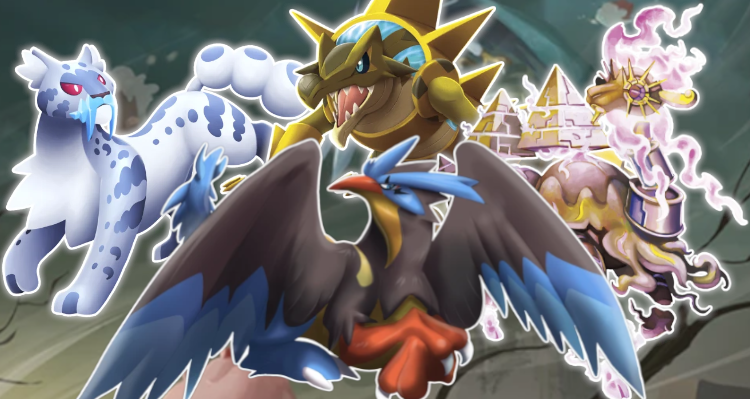
Let’s Talk Towers
Author
Published
For those who have followed my deck building choices and preferences over the years I have played TCGs, there has always been a common factor in my deck choices: I like to make my opponent extremely uncomfortable with my end boards.
In Yugioh, this mostly came down to me playing combo decks like HERO that aimed to set up extremely uncomfortable board states that the opponent would have to navigate while losing almost every card they played. For Pokemon I dabbled in the odd Oranguru Stall to create truly heinous end game scenarios. For Elestrals, it has mostly materialized in that I prefer decks that play a big untouchable bungus that makes the opponent say, “How am I supposed to beat that?”
This is going to be a guide going over the current Towers strategies in Elestrals. What they are, how to play them, and the one part I should not discuss if I wanted them to be relevant: how to beat them. My win rate be damned; into the trenches we go. For starters, I guess we should start with a question that the uninitiated might have…
What is a Towers?
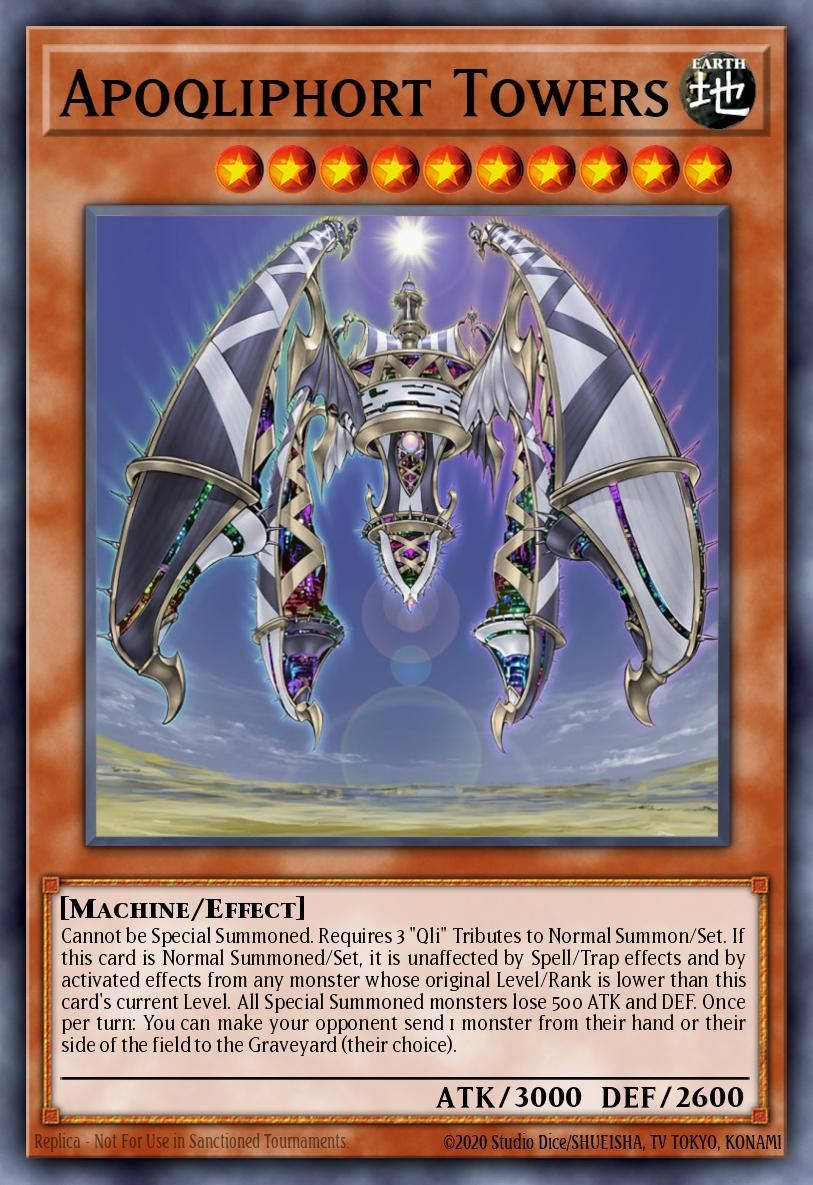
Apoqliphort Towers was a monster in Yugioh that belonged to the Qliphort archetype, requiring 3 tributes to normal summon, but if you did was completely unaffected by spells, traps, and the effects of monsters with a lower level or rank than its own, being 10. This was a card that was in many respects a first of its kind for the game, as while there were cards that came before that had effects that gave levels of immunity, none could really compare to Towers, as it was easy to tribute summon thanks to Qliphort taking advantage of the newly released (and incredibly broken) Pendulum mechanic, was searchable in its own deck, and gave such blanket immunity that if it hit the board, the game was as good as over if you didn’t play one of the very specific outs to it.
This card was so revolutionary in its own game that it led to the creation of an entire archetype dedicated to ensuring a Towers never dominated unopposed again in the Kaiju monsters as well as coined the term Towers to refer to as any mostly immune boss that you’d sit on to win the game with. With many of the prolific Elestrals players migrating from competitive Yugioh, it was inevitable that the game’s terminology would also migrate.
As such, Towers cards in Elestrals standardly refer to cards that have some level of immunity that keeps them from being easily removed, more specifically by common removal options like Earthquake and the counter rune suite. This ranges from partial immunity found in various 2-drop Elestrals, mostly those found in the first 2 sets, to more blanket immunity found in 3-drop Elestrals that provide profound headaches for their opponents. With that in mind, let’s start with the lower class and work our way up.
Partial Immunity is Still Immunity (The Lesser Immunities)
The Elestrals that fill the niche of Tower-lites fall into one of 2 categories: Invoke Immunes and Counter Immunes. None of them are immune to both and all of them have a counter among the line-up they are not immune to.
Invoke Immunes
Main Deck
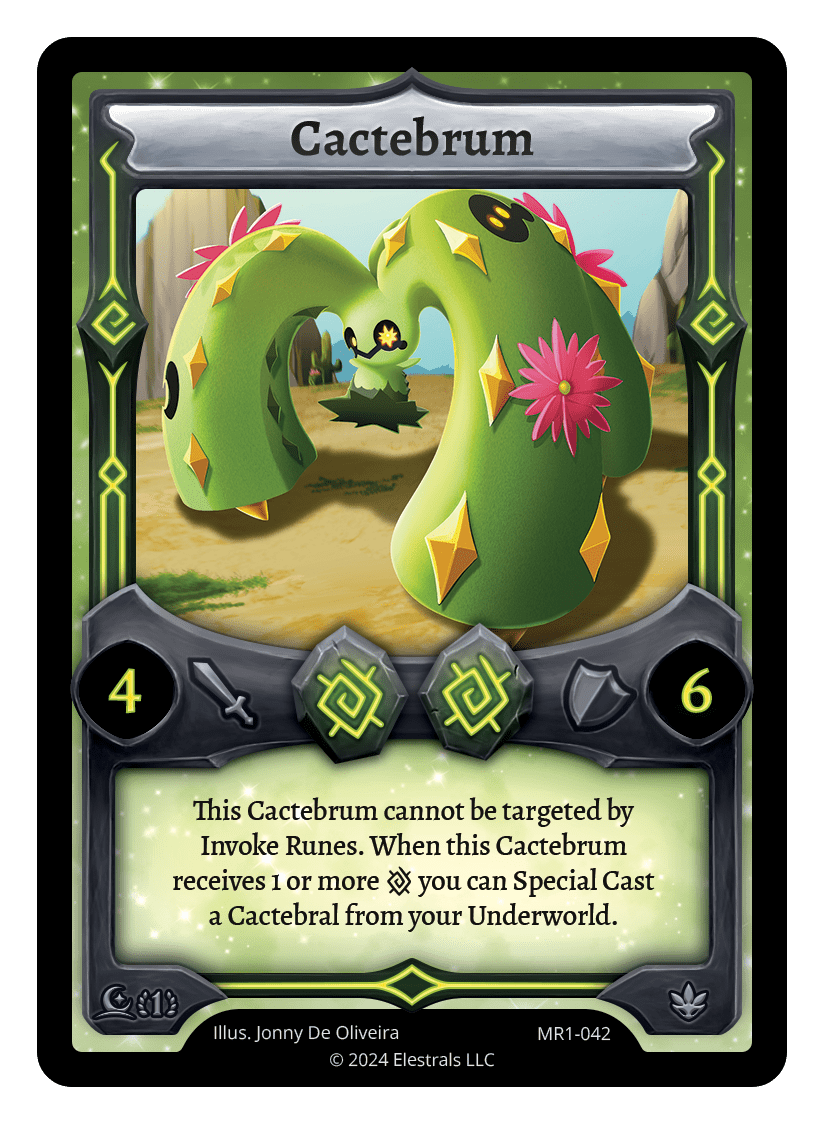
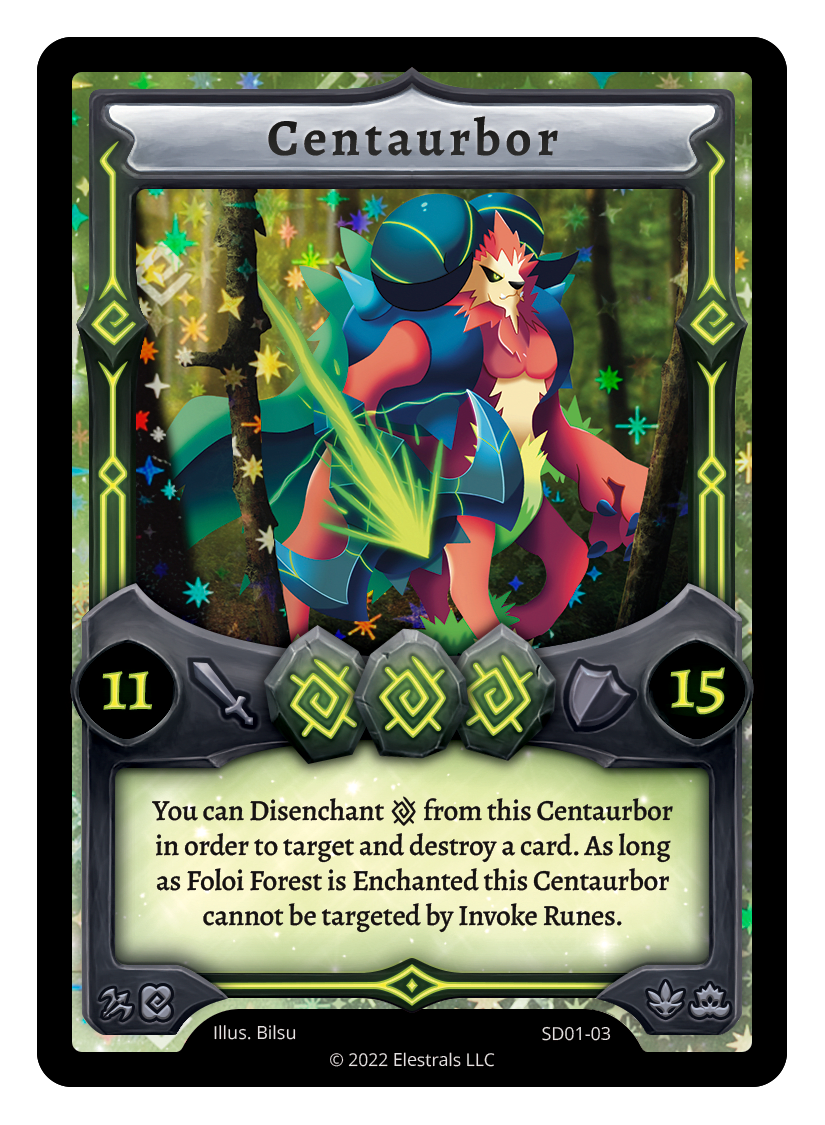
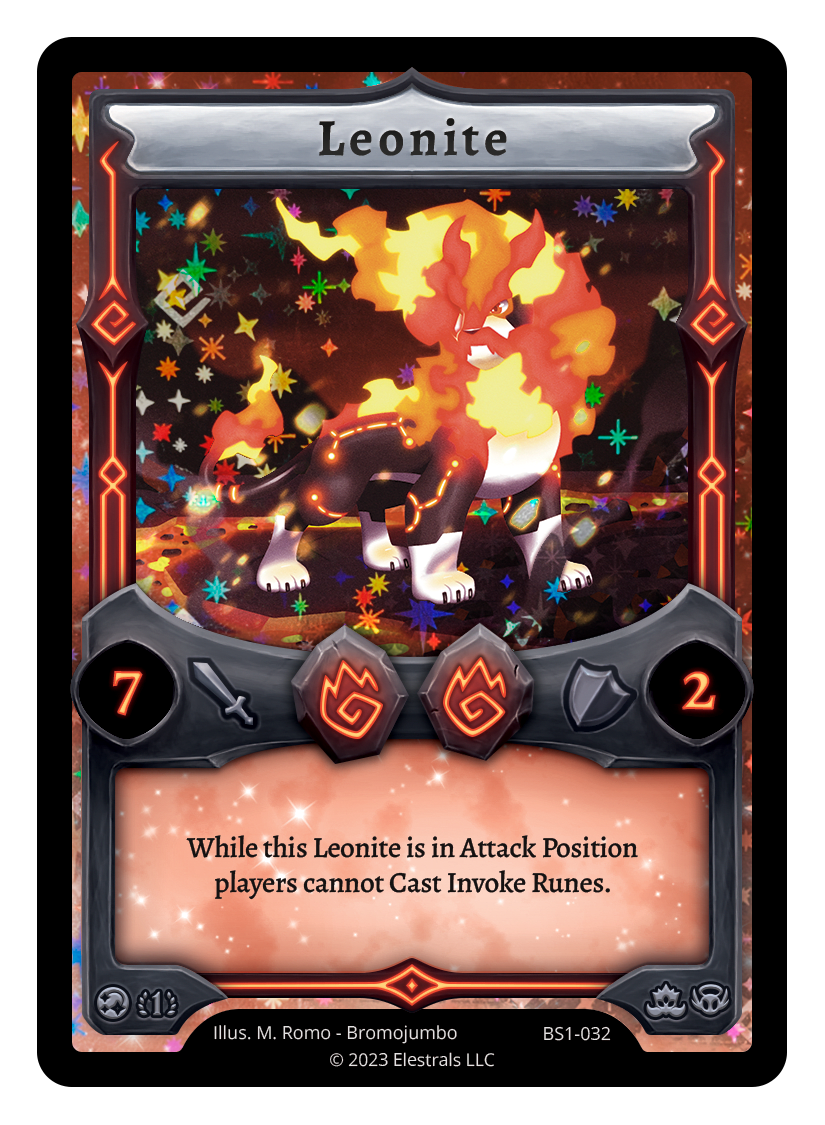
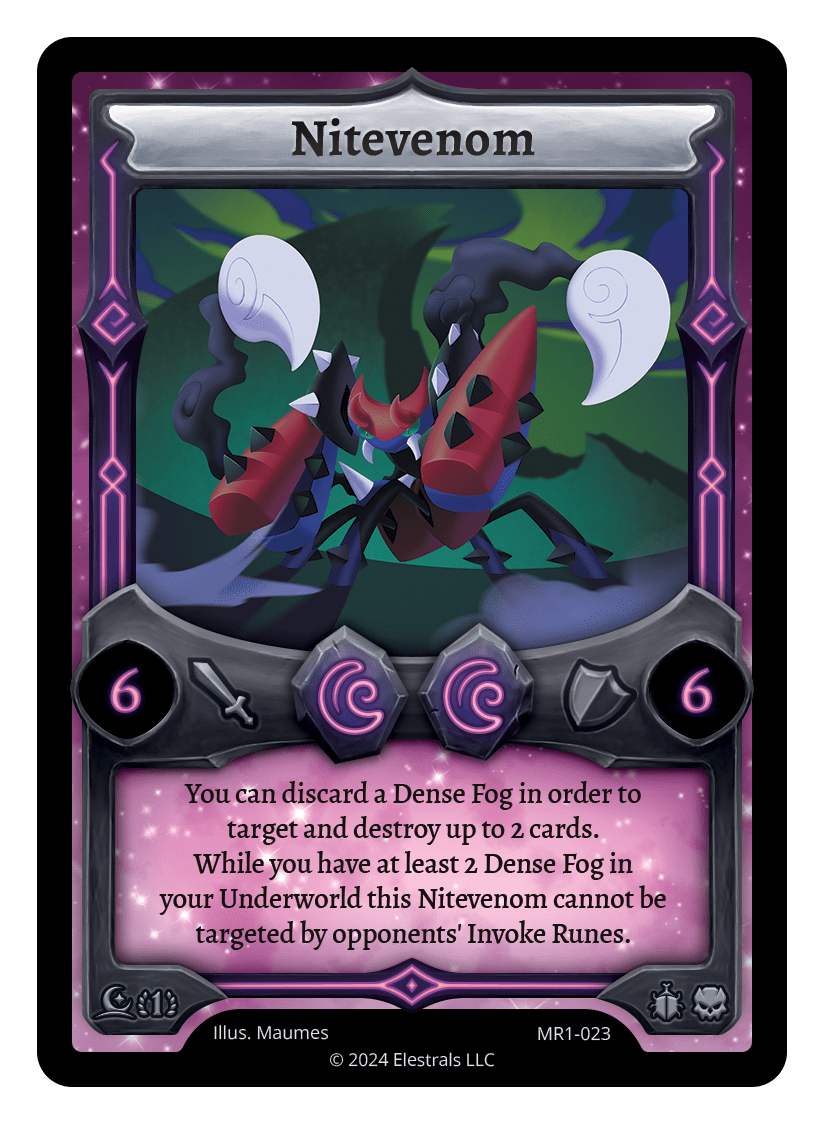

Starting with the invoke Immunes, these Elestrals are particularly great defensive options because they can survive most threats that would be deployed on the opponent’s turn. These have historically been underutilized in the meta game due to one major factor: they do not win the game. Cactebrum is probably the most prime example of this, as it’s a high defense wall that can regurgitate its offspring to the board to stop the other side of its rune immunity, but in the end can just get walked over by a whale.
Nitevenom doesn’t fair much better, needing 2 copies of a specific rune in the underworld to get its immunity, though does have better stats so its not as easy to run over. He might be worth revisiting if we ever see a Dense Fog titled version, but considering it wasn’t leaked in the Artemis starter, I’m not holding my breath.
Centaurbor is in rough shape right now, needing a Stadium to be up for only an Invoke immunity, which makes it already worse than a 2-drop we’ll be discussing in a little, but is also a 3-drop, taking astronomically more investment to connect it to the board in the first place. While you CAN circumvent this with Satymber and it DOES have the disenchant pop tied to it, sadly all aspects of this card were obliterated in Daybreak with another card we’ll be discussing in its own section, so we’ll put a pin in that for now.
Leonite is about the best you could ask for offensive prowess on an Invoke immunity, being a 7 attacker, but sadly this brings us to the other side of these cards: they lose to EVERY counter rune. Obviously, Poison Tipped Arrow and Shield eat them alive, Gorgons makes their immunity worthless, Tsunami is going to connect every time since you wont be misenchanting them and none of these have water naturally, and because their stats are all on the lower end, Argo makes quick work alongside any decent stat line.
That leaves us with just Nyximera – Fallen Form, which in my opinion is the best of this concept solely because being a wall is all it NEEDS to be. Because of its tag out nature with Risen Form, in many respects it does what it needs to do: survive the turn so you can access Risen and pop the counter runes for your push. This is not perfect, as you’ll be spending an astronomical amount of spirits to maintain the line over multiple turns, which can be reinvested into your runes via syphoning but still commits them to your board in the first place, but also because the line falls horrifically to a well-timed Poison Tipped Arrow. Let me explain:
· You cast Risen Form. You pop one of 2 backrow and hit a shield, perfect!
· You tag out in the End Phase into Fallen Form, ready to coast through the turn.
· The opponent flips the PTA in the End Phase cast of Fallen Form. They now can payout immediately and slay the Nyximera.
You’ve now spent 4 spirits to the opponent’s 3, and that feels beyond awful. Now while this isn’t a deal breaker for Nyximera, you have to connect the pops every time to make it worth it, and that takes a LOT of spirits to maintain. With that in mind, here’s my current list.
Main Deck
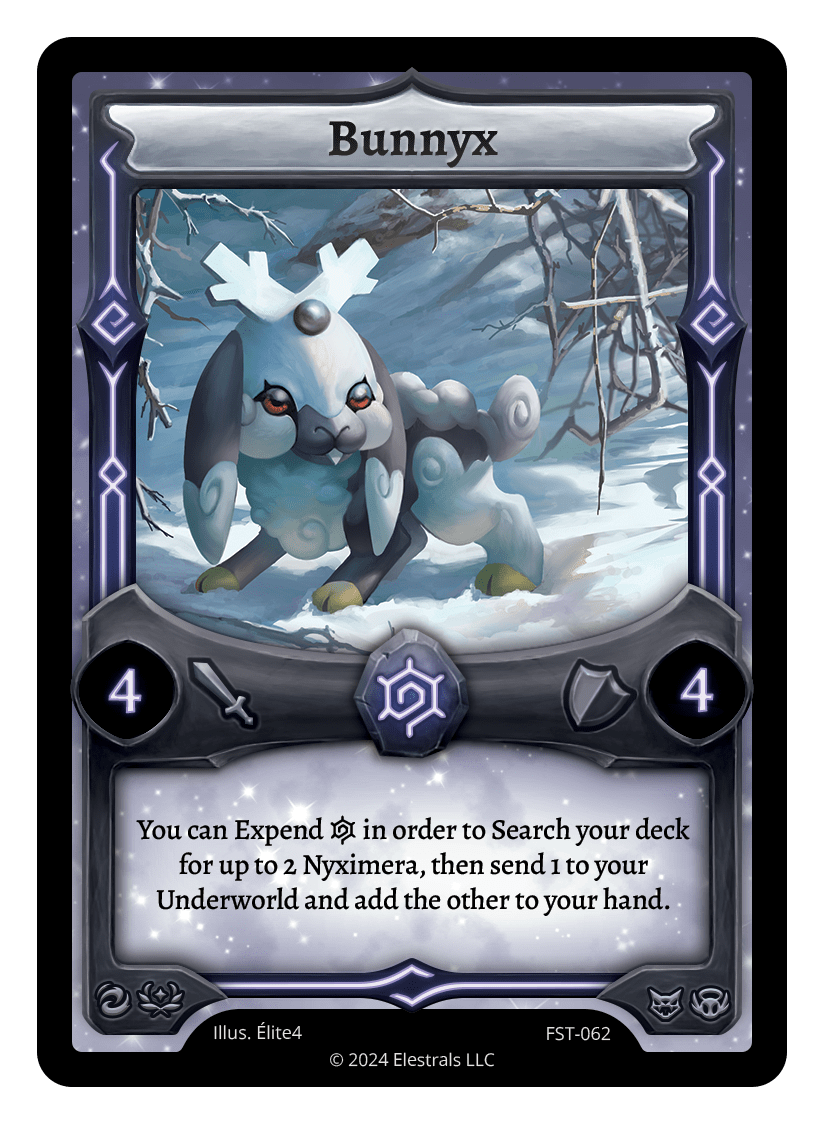


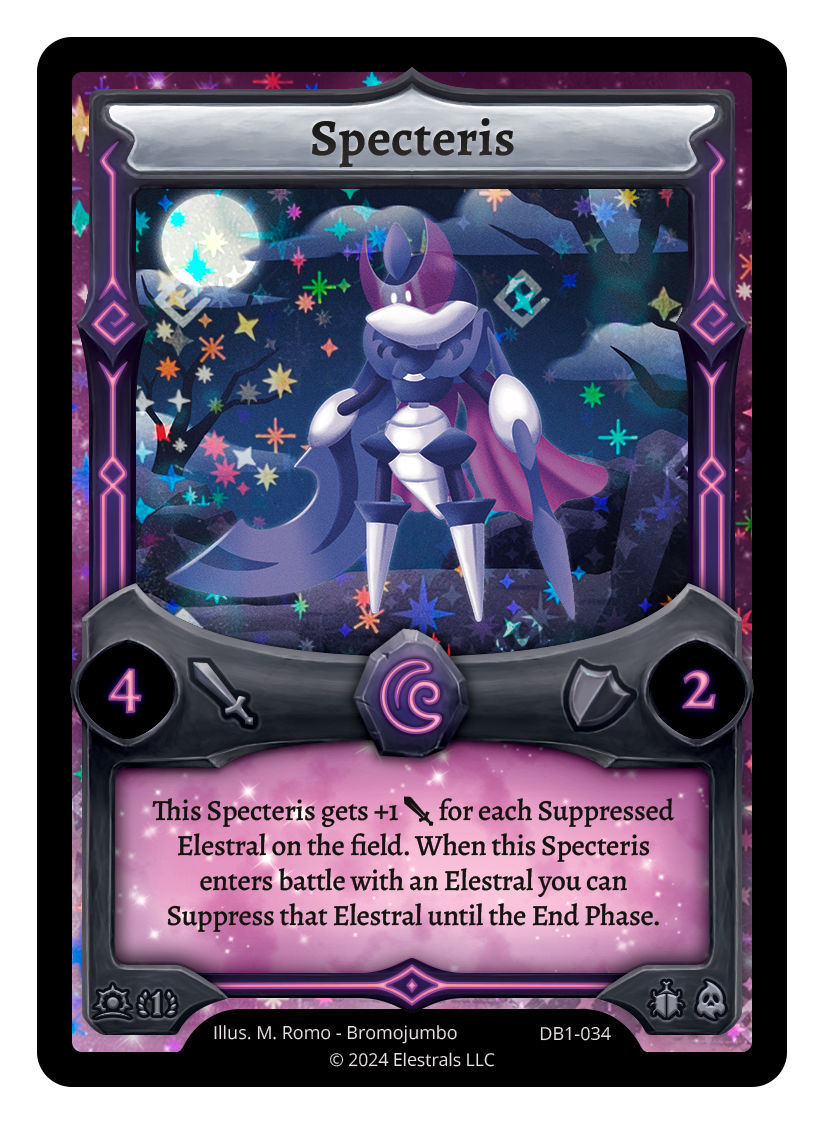







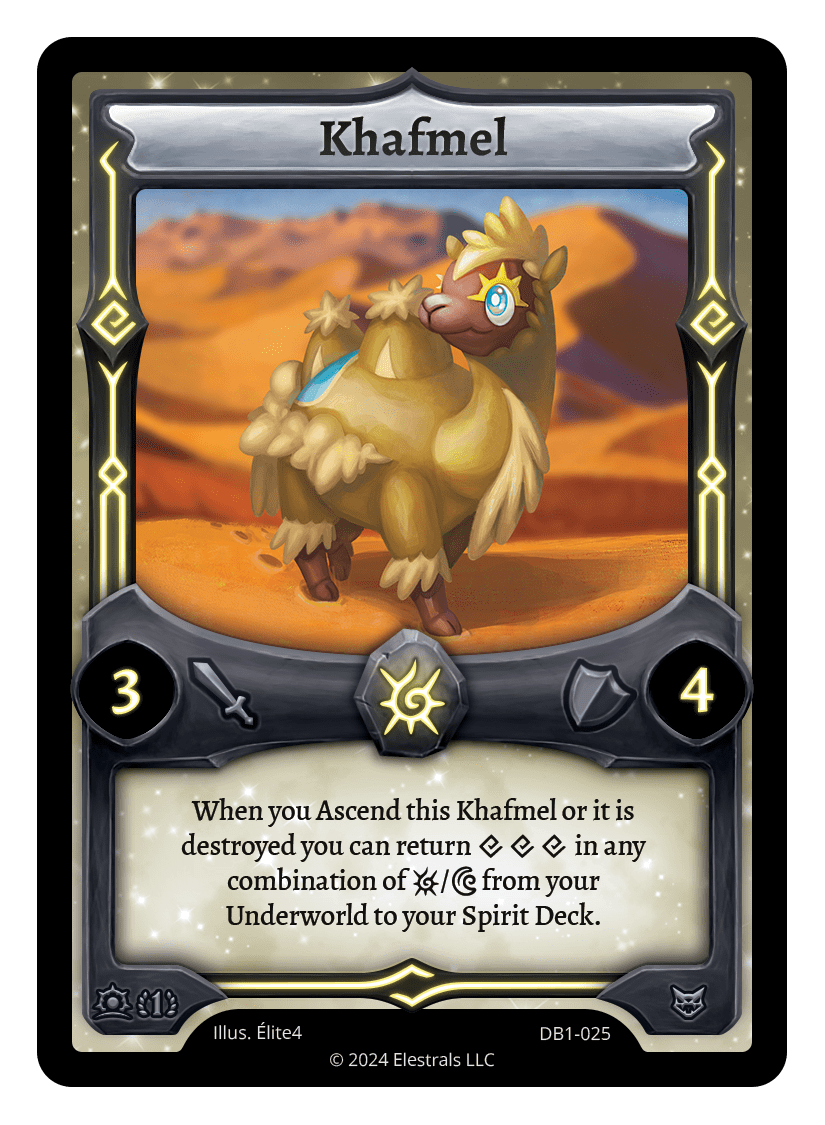

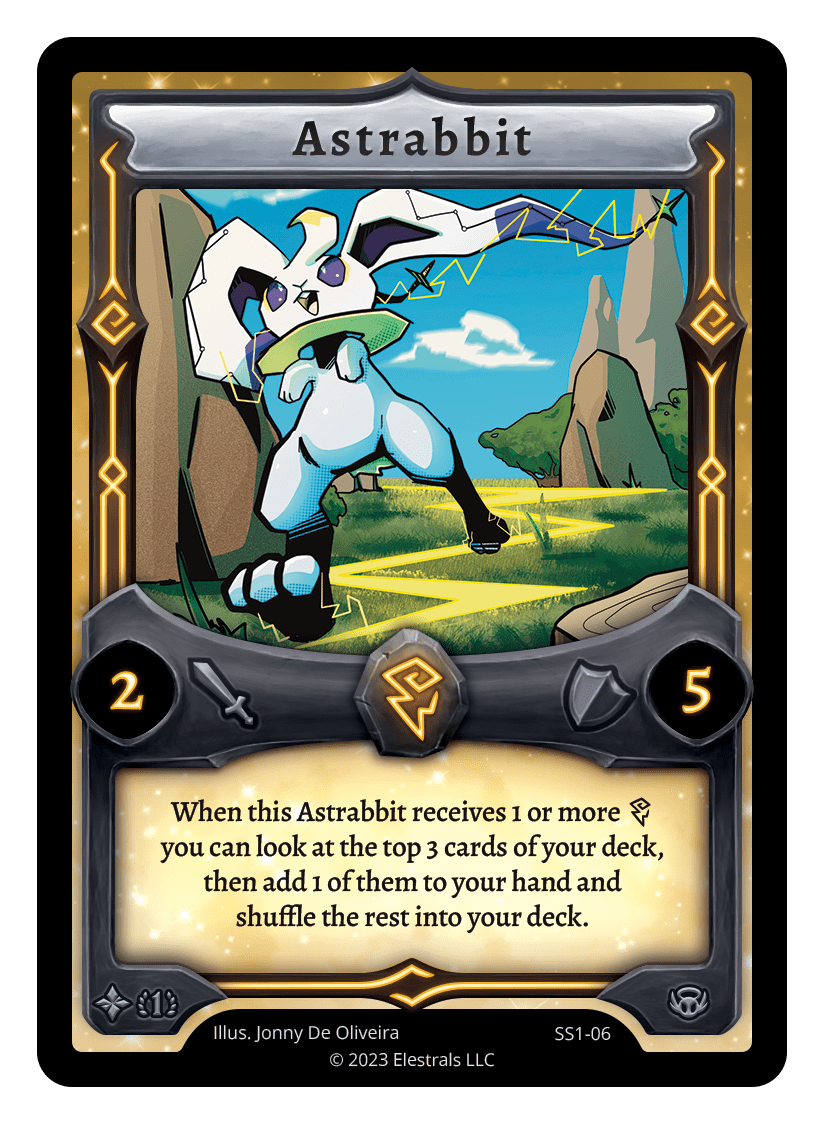









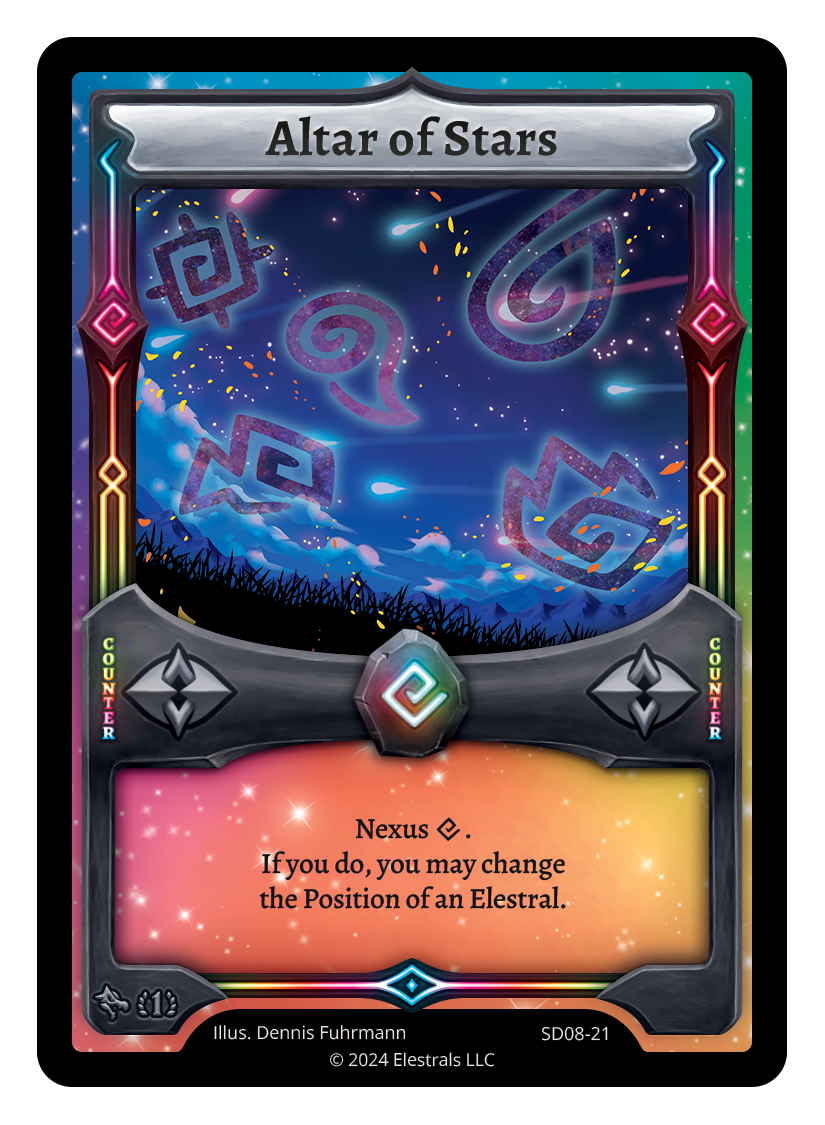

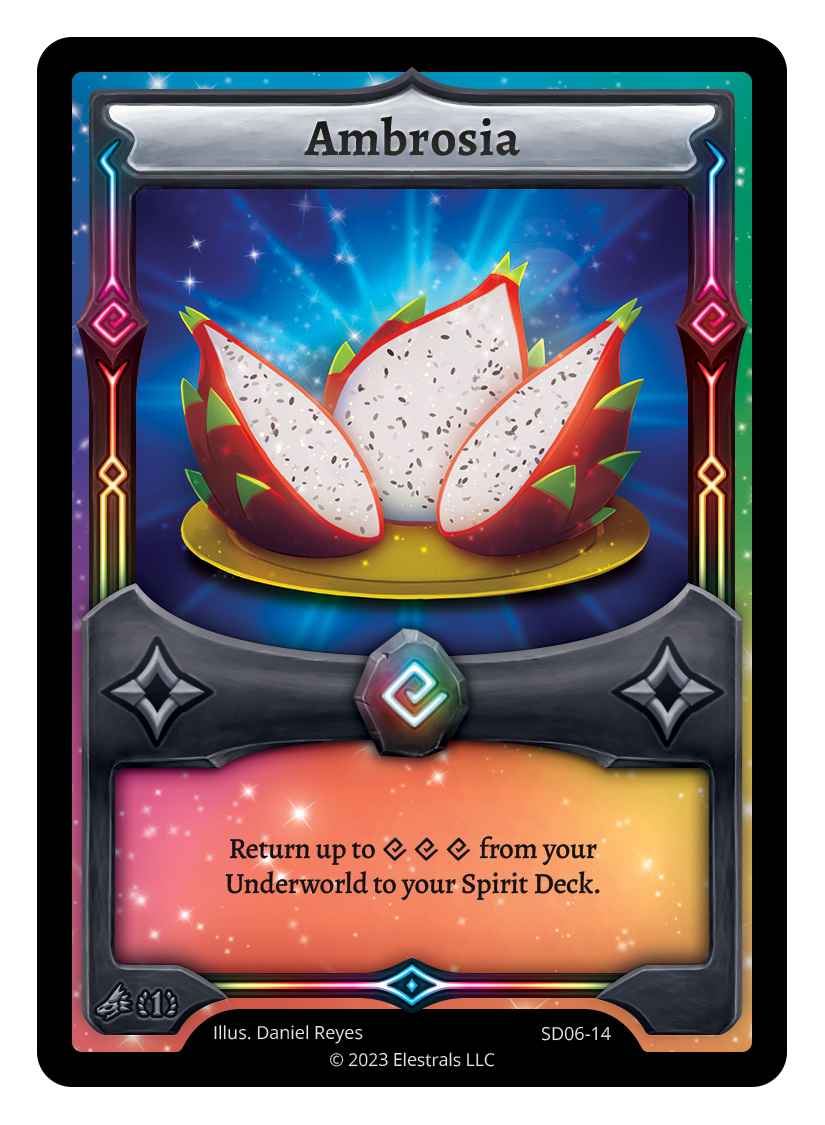


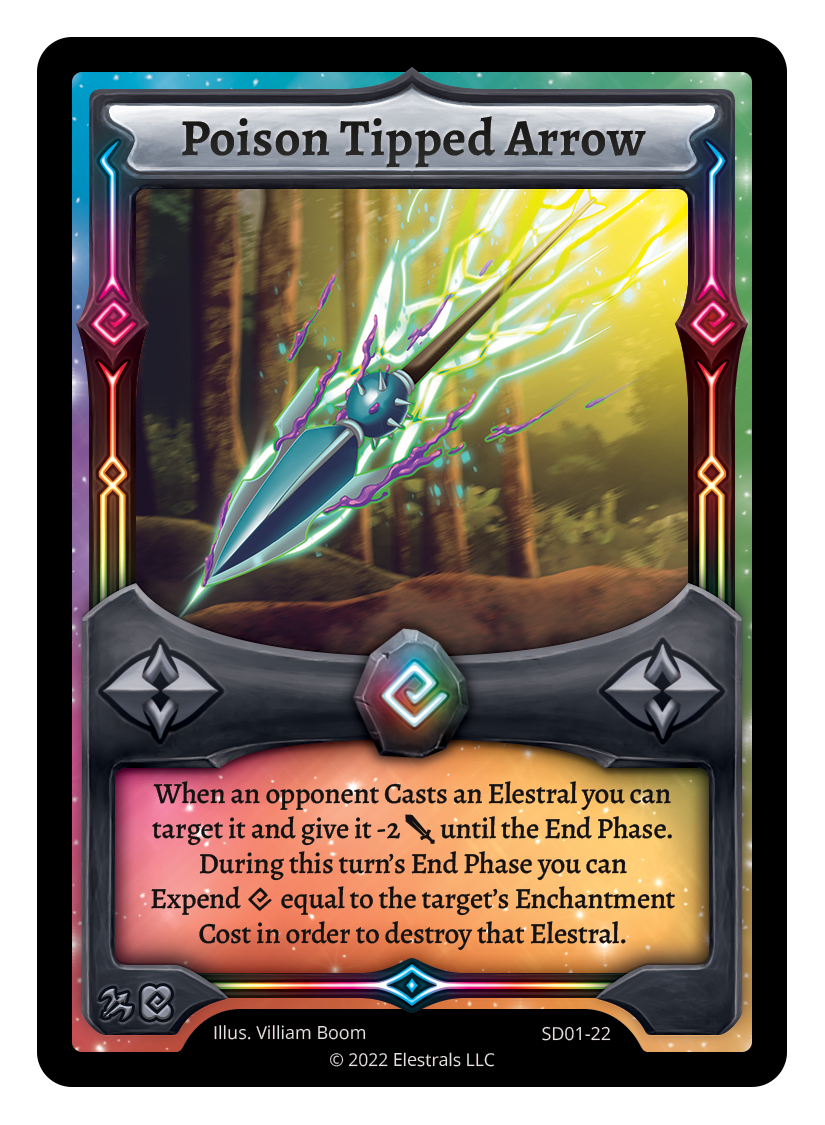

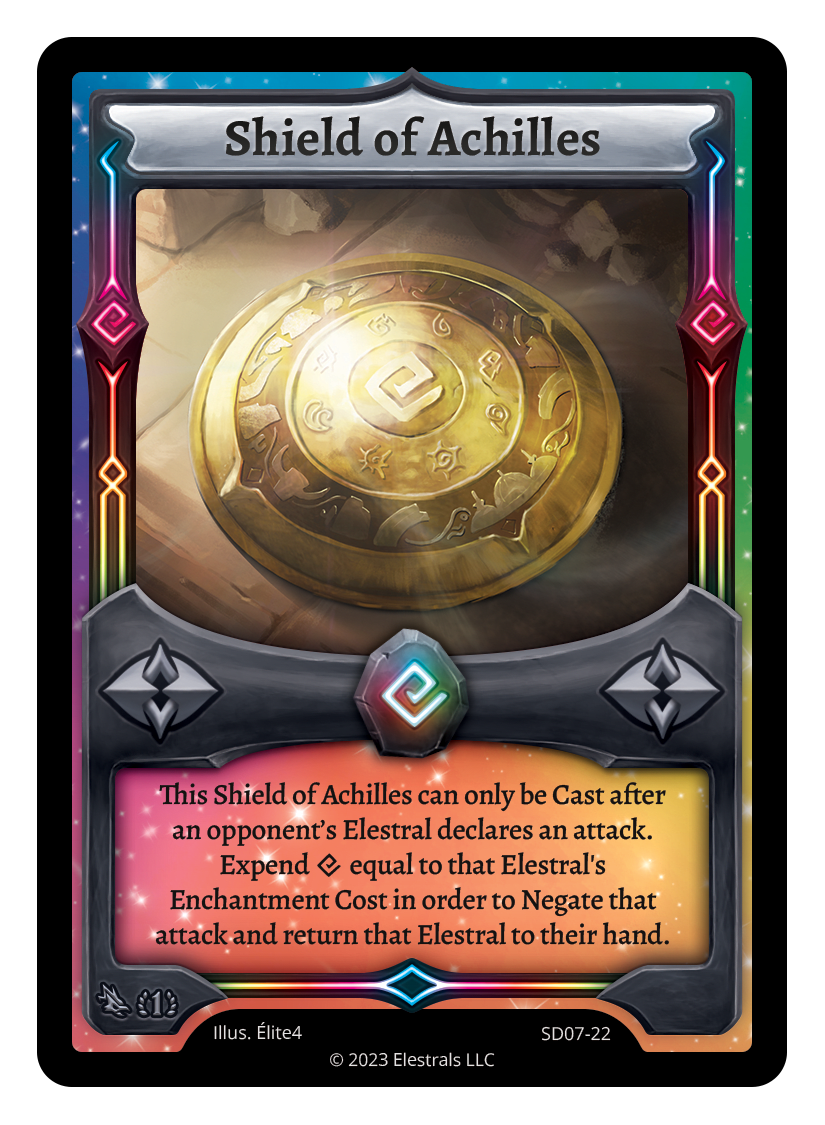


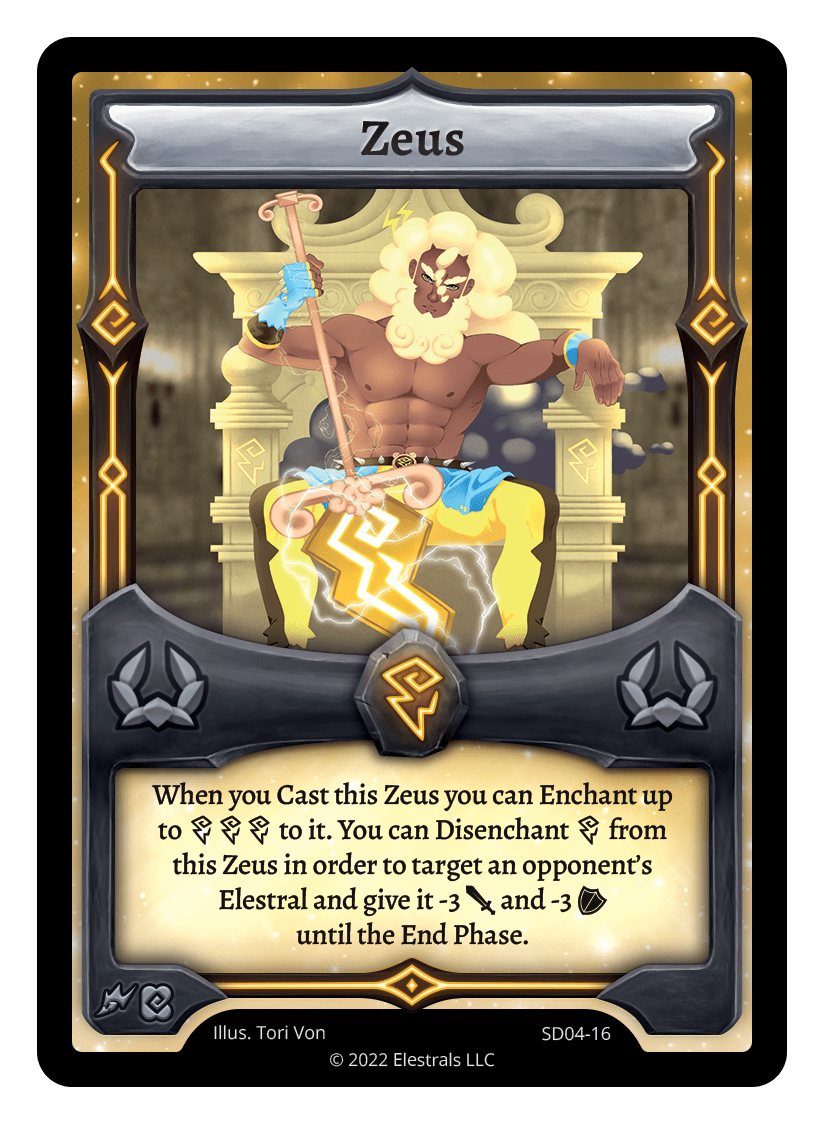

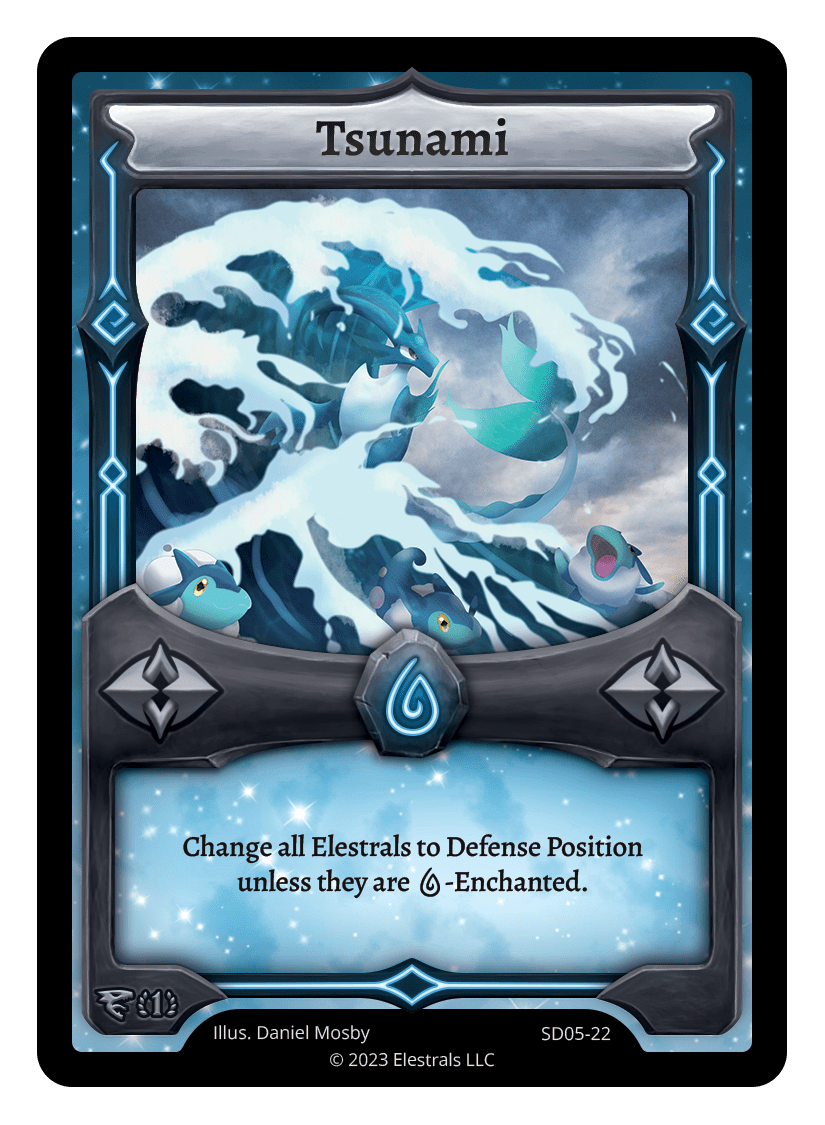

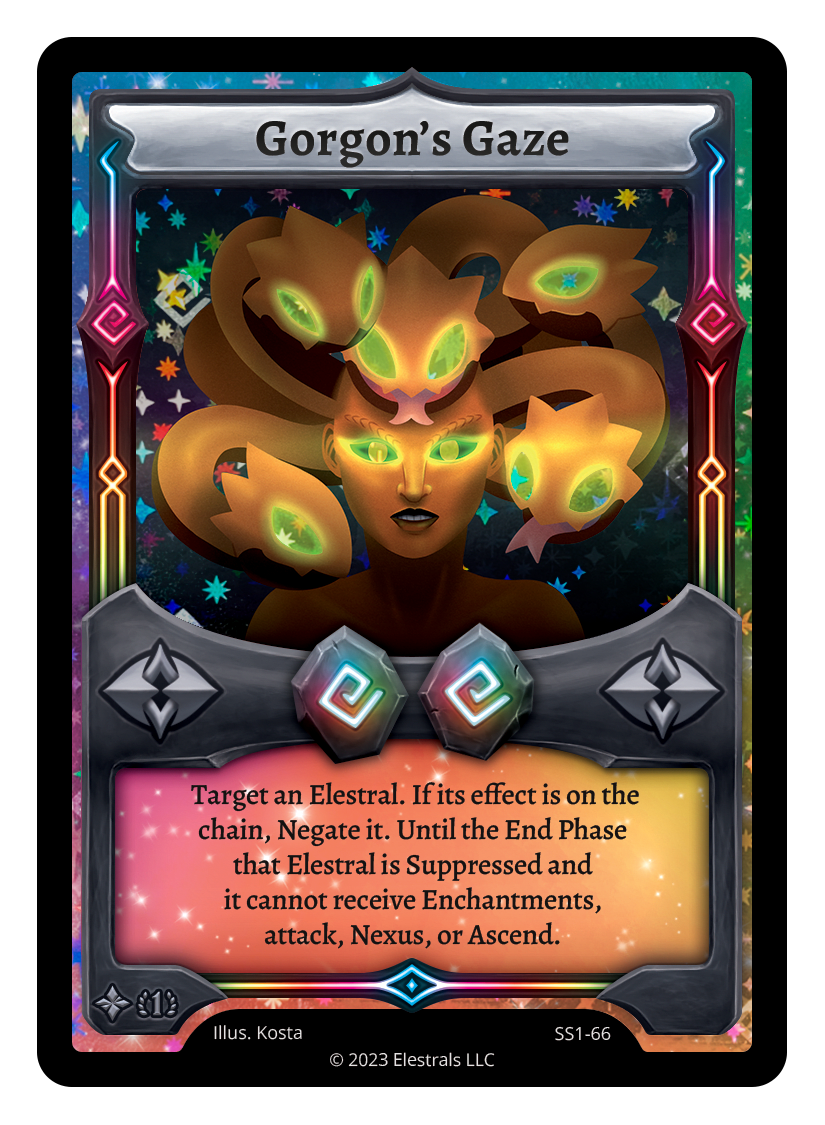


Spirit Deck
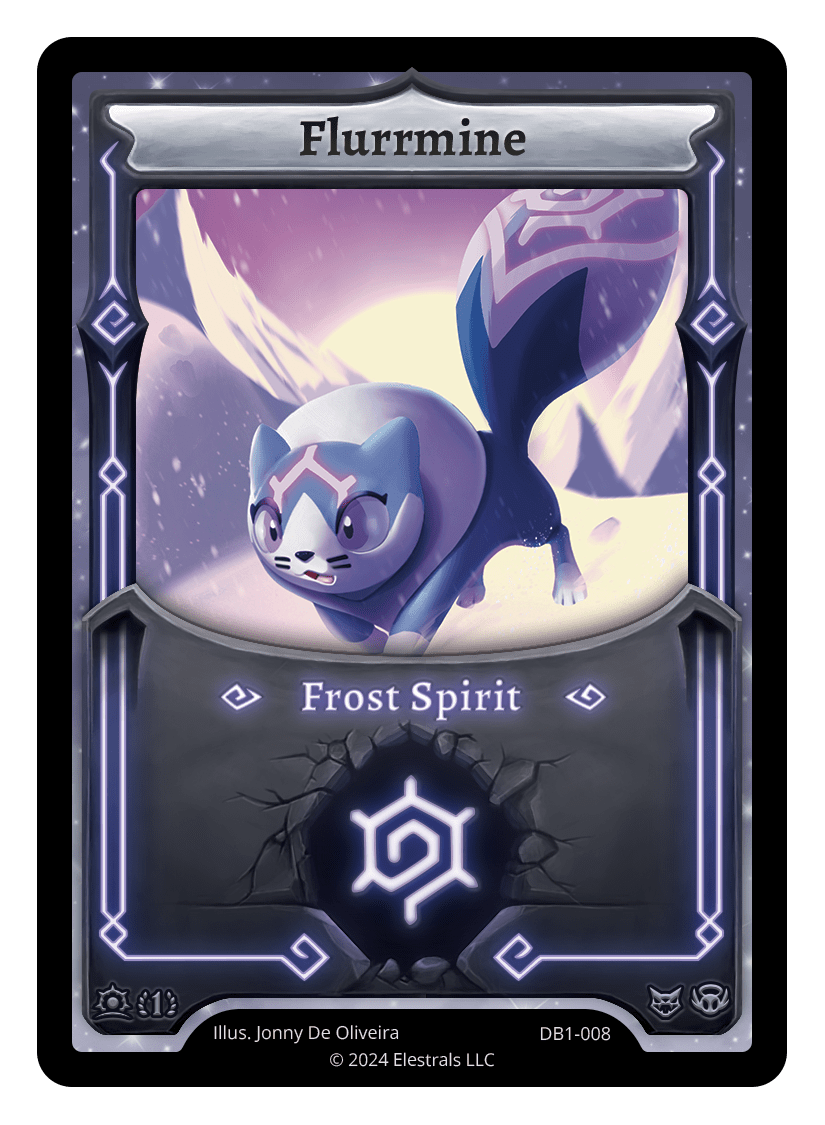


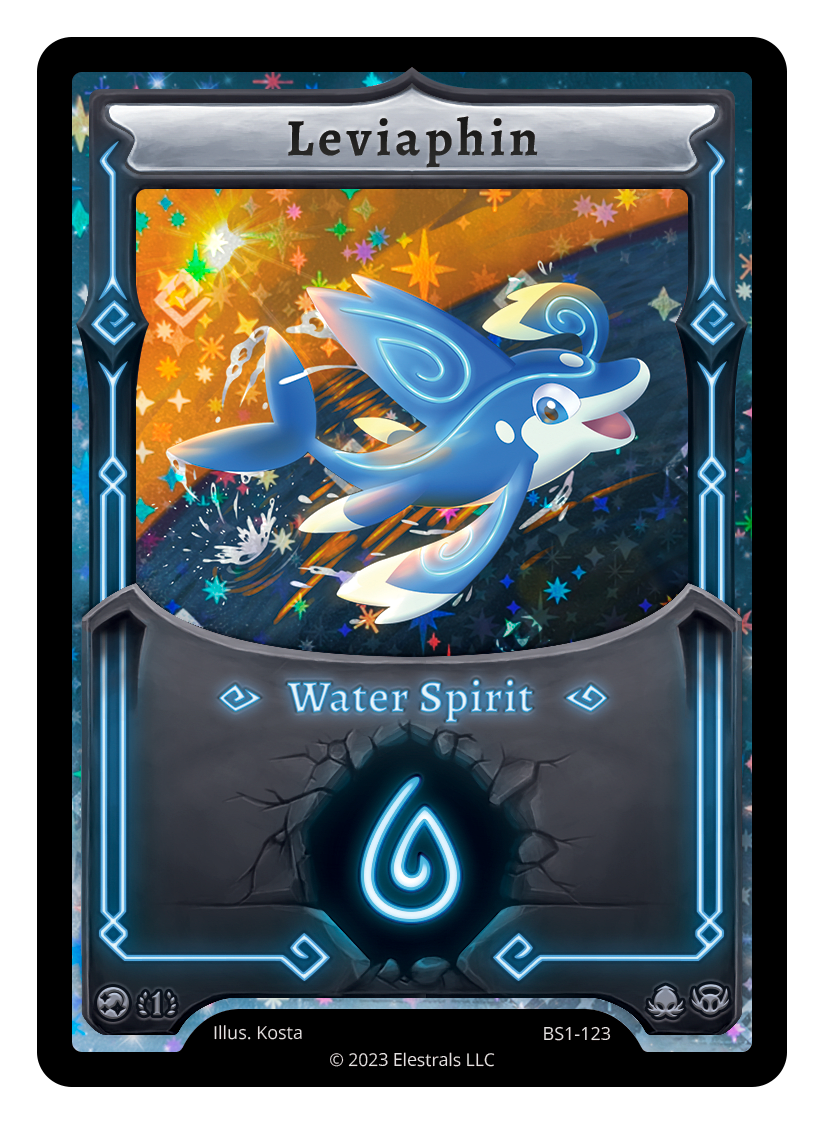



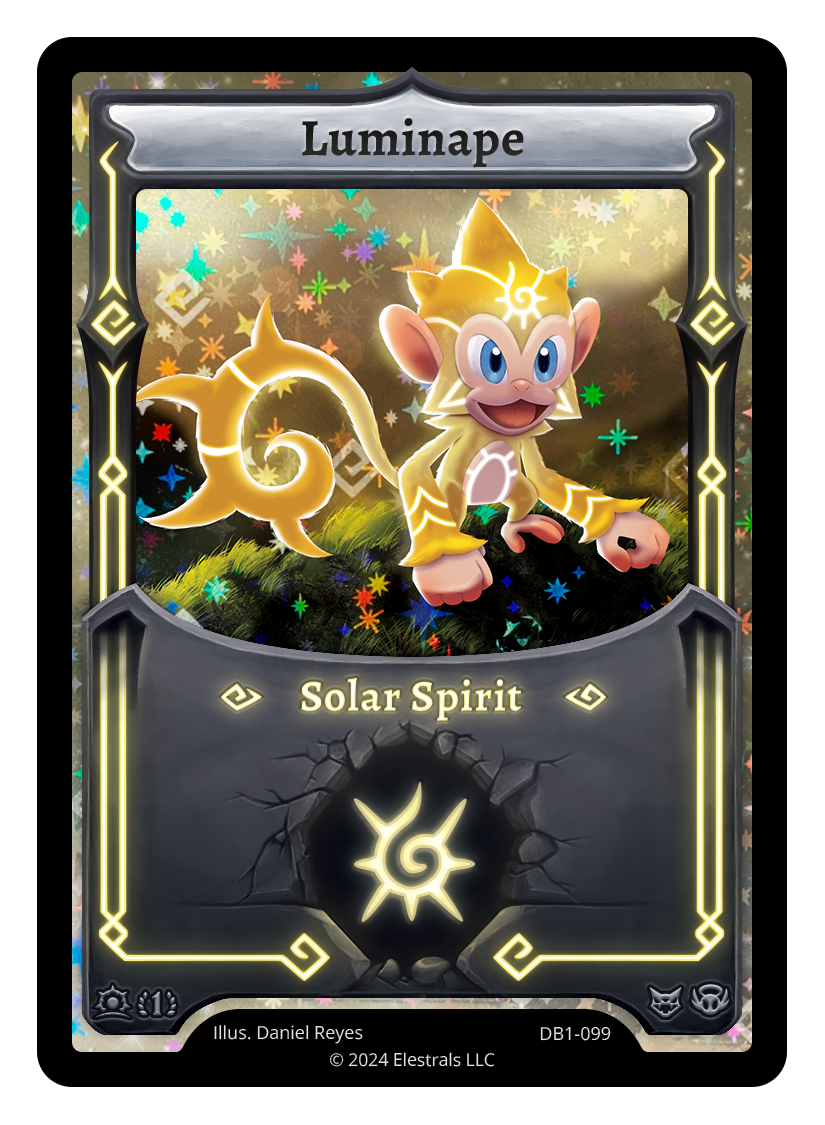



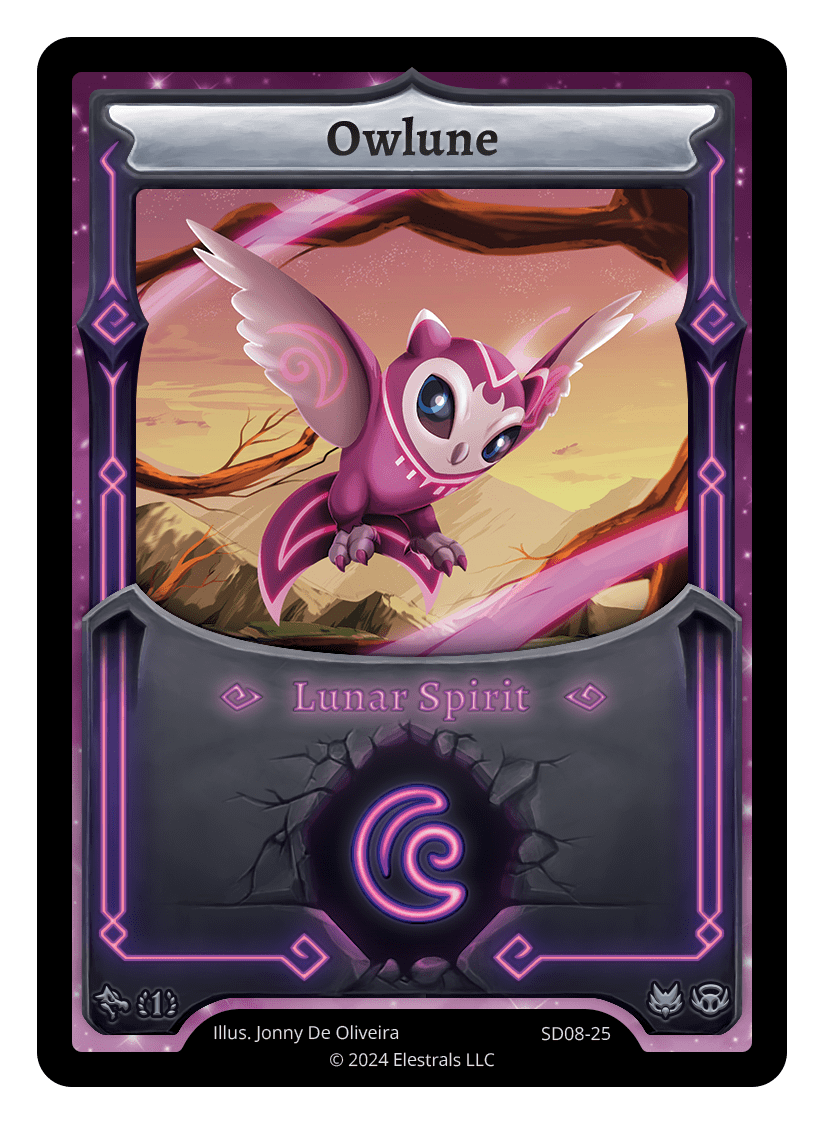




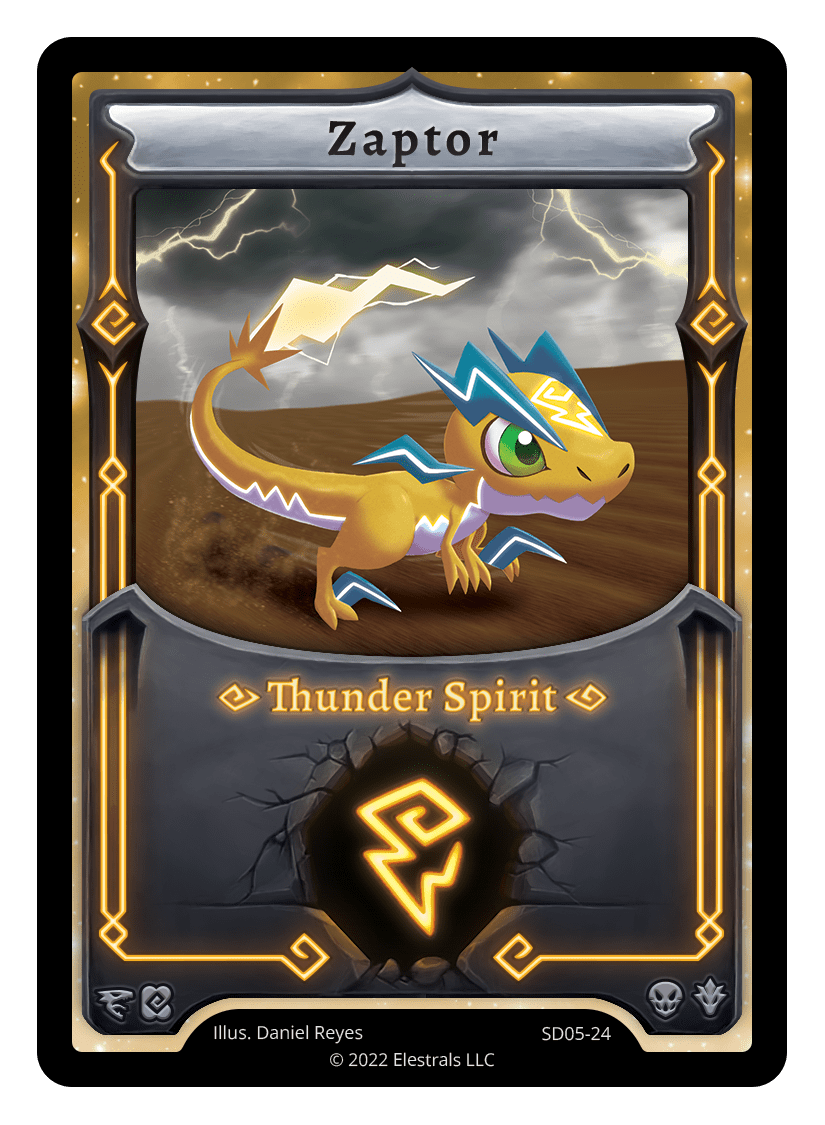



We want to prioritize longevity over power, so refocus your efforts on spirit management when you take this strategy for a spin and you’ll go farther.
Counter Immunes
Main Deck
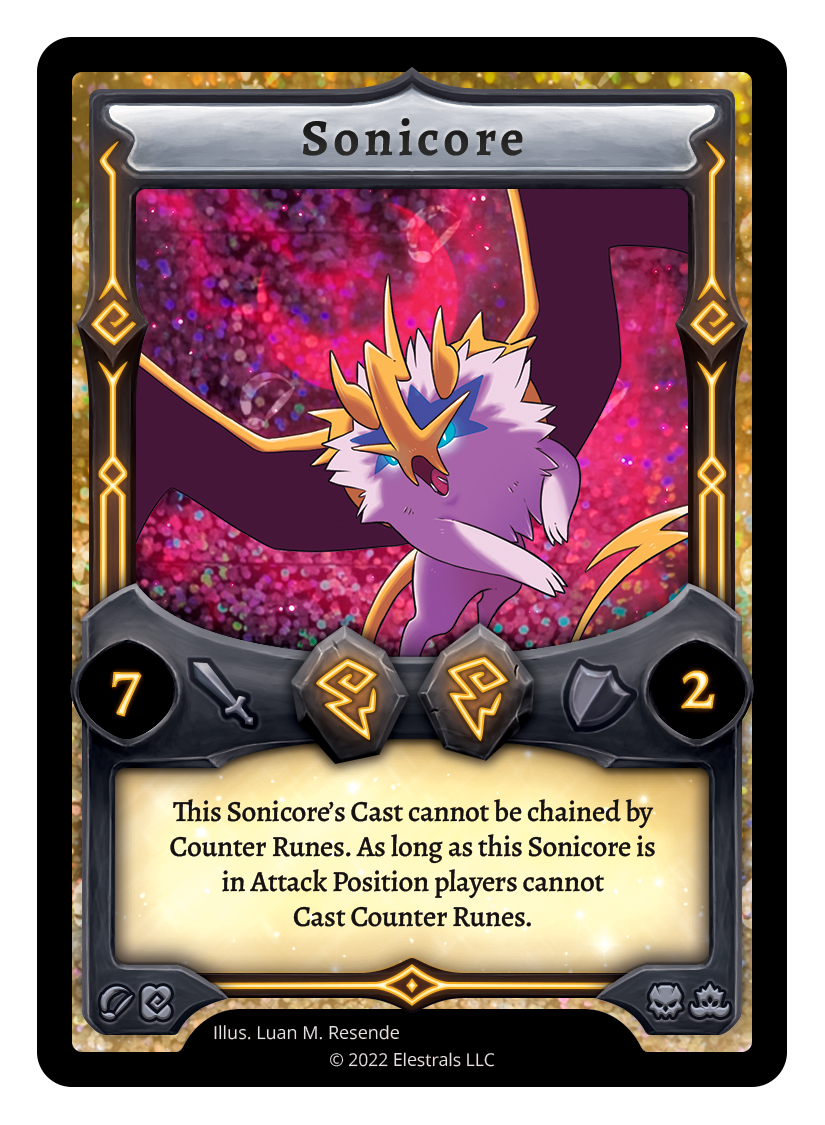
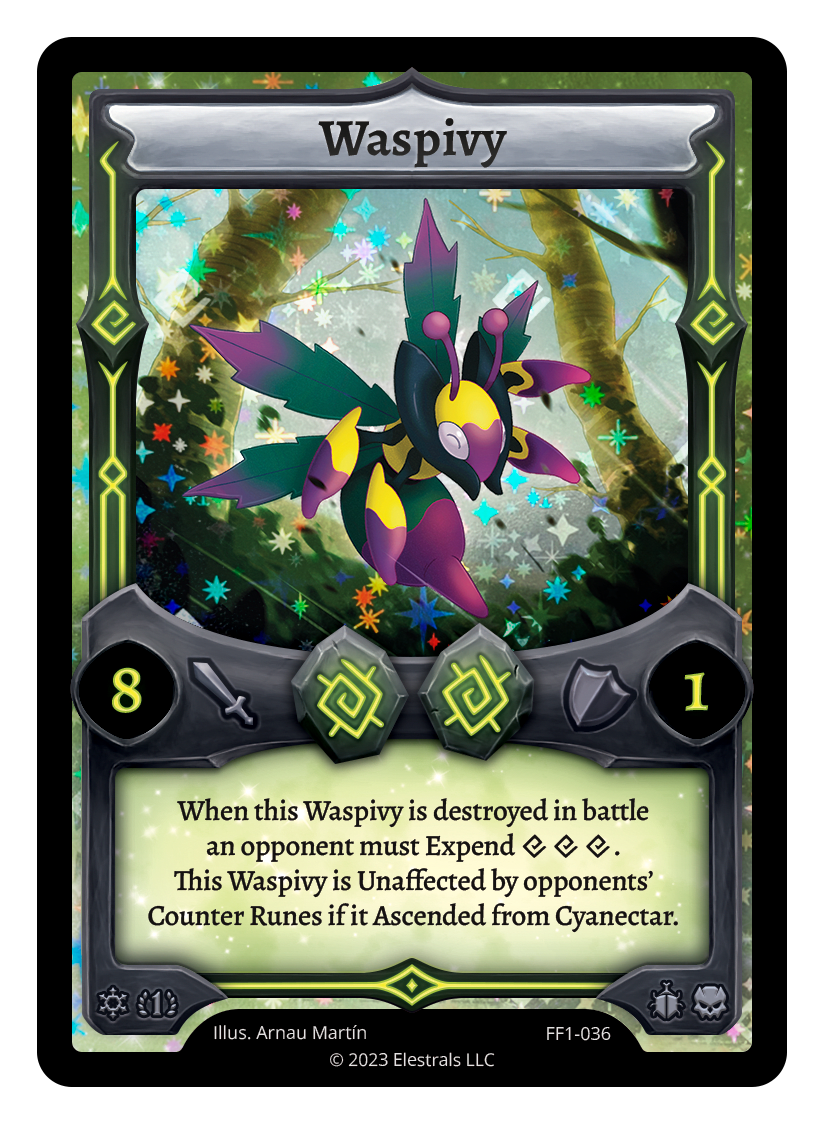
On the other side of the coin are the Counter Rune immunes, of which there are only 2 currently, being Waspivy and Sonicore. These cards are far more aggressive compared to the Invoke immunes thanks to having a minimum of 1 turn after hitting the board to accomplish a push, as no counter runes will be able to affect them.
Sonicore is the older of the 2, and also the more generically applicable, seeing as how you do not need to fulfill a specific condition to access, just needing to hard ascend into it over a thunder enchanted Elestral, at which point the opponent cannot even respond, as it locks counter runes the moment it goes on the chain. He also, rather than being immune, locks ALL counter runes, which does come with the downside of losing your own Counter Runes, leaving you weak to a counter push the following turn, as the opponent can set up risk free THEN remove the Sonicore.
Waspivy on the other hand appears to be a strict upgrade: better attack, keeps your options live, and even disincentivizes the opponent from removing it via combat with its burn condition. The catch is that it is not nearly as generically accessible as Sonicore thanks to needing to ascend over Cyanectar.
Though that may be a downside, it can also be a massive positive thanks to Cyanectar’s ability to ascend into Waspivy from deck any time one of the Poison runes resolve (Poison Tipped Arrow, Poisoned Nectar, and Poisoned Tunic) on EITHER side of the field. Because of this interaction, Cyanectar connecting to the board can leave the opponent in an incredibly uncomfortable situation, leaving them unable to use PTA, the 4th most played counter rune, as well as making your Argo lines far more explosive, as you’ll not only shut off attacks for the turn, but also stick Wasp going into your turn, an undesirable position for any opponent.
Sadly both of these options are decently easy to remove on the opponent’s turn thanks to only holding immunity to counter runes, so options like Earthquake and even Cryoblast can remove them no problem. Galaxea Champ and Eddy or a well stated Elestral with a Zeus can also do the trick, but in the case of Wasp that option is less desirable thanks to the battle destruction burn. With that in mind, here’s my current Wasp list.
Main Deck
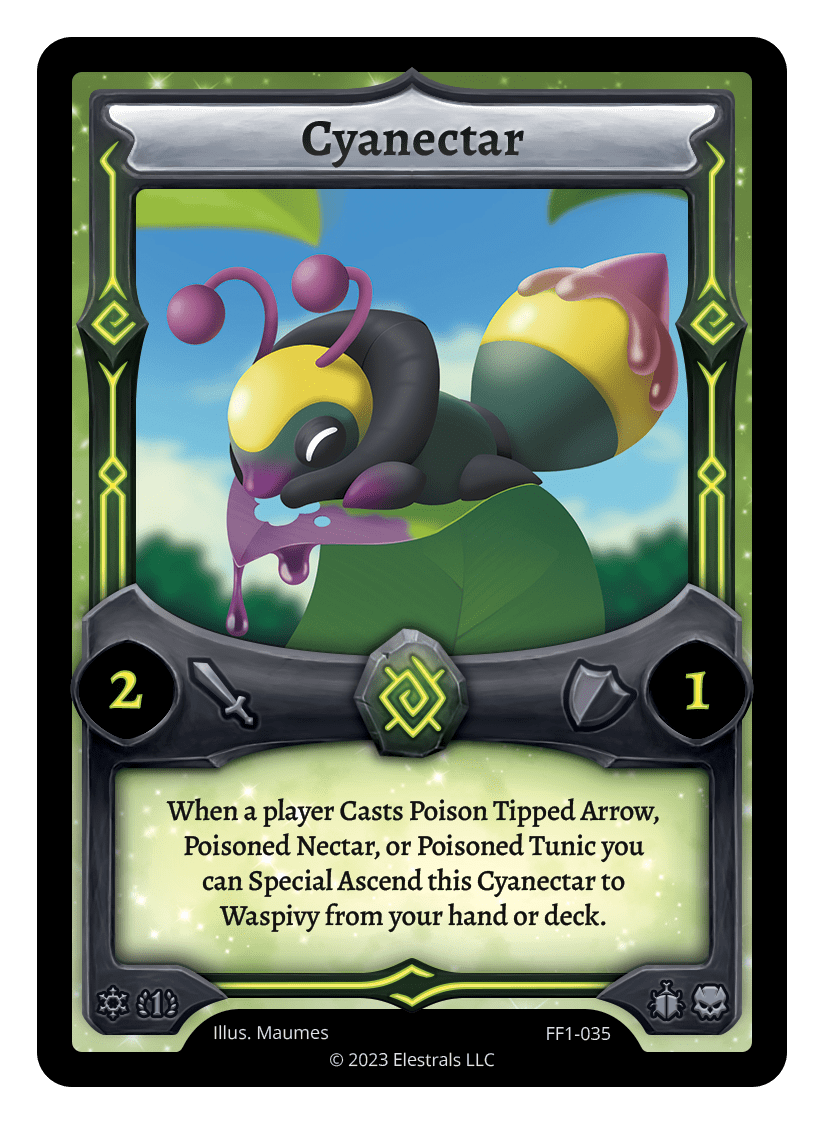


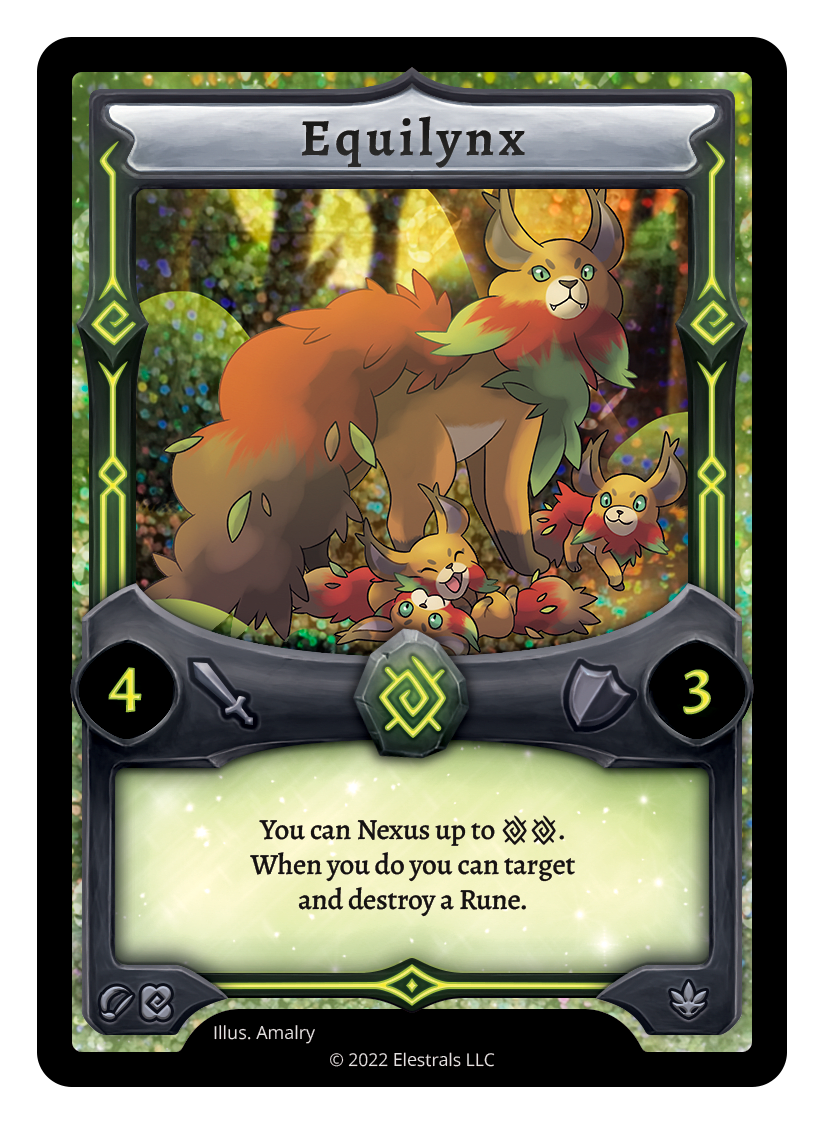
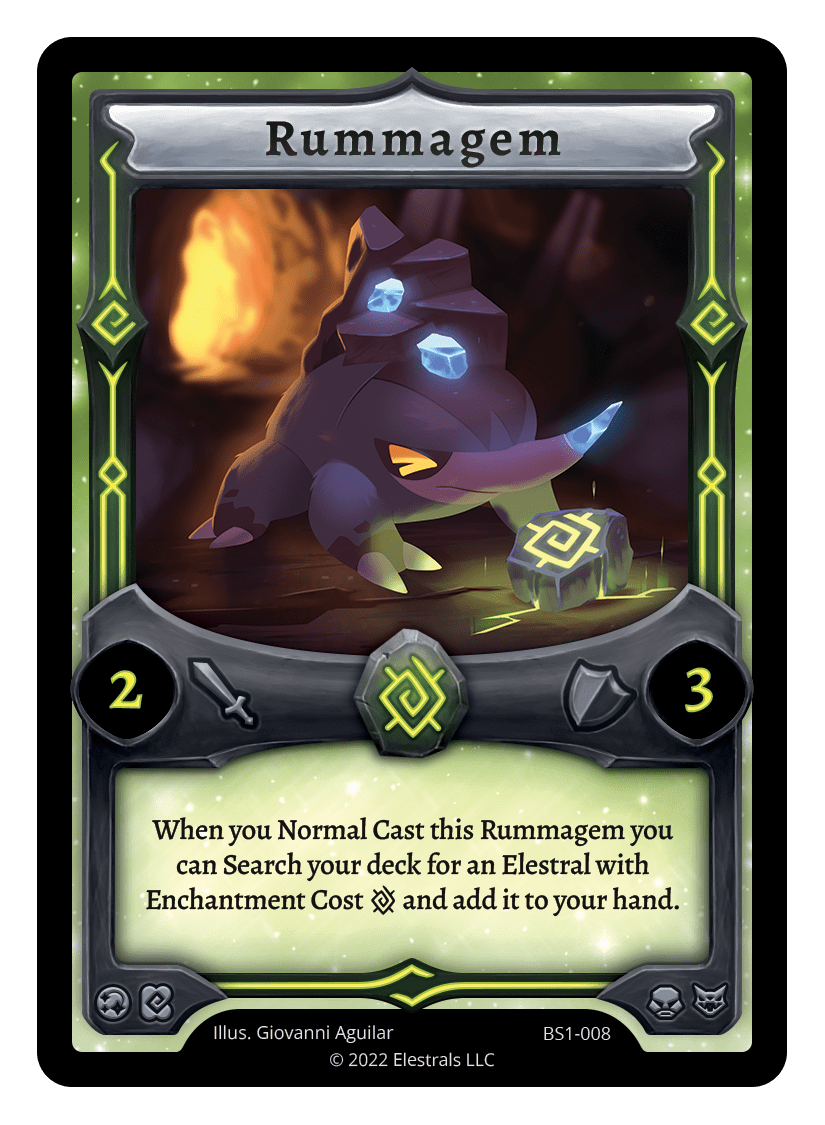
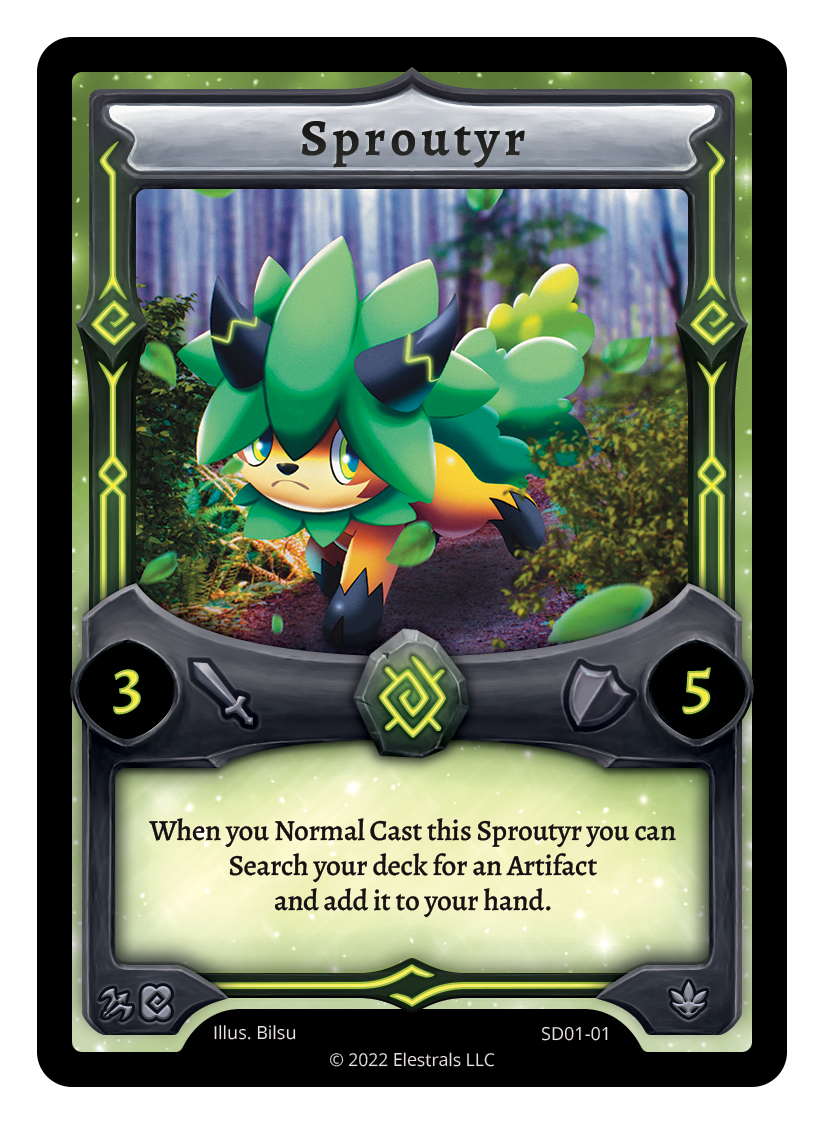

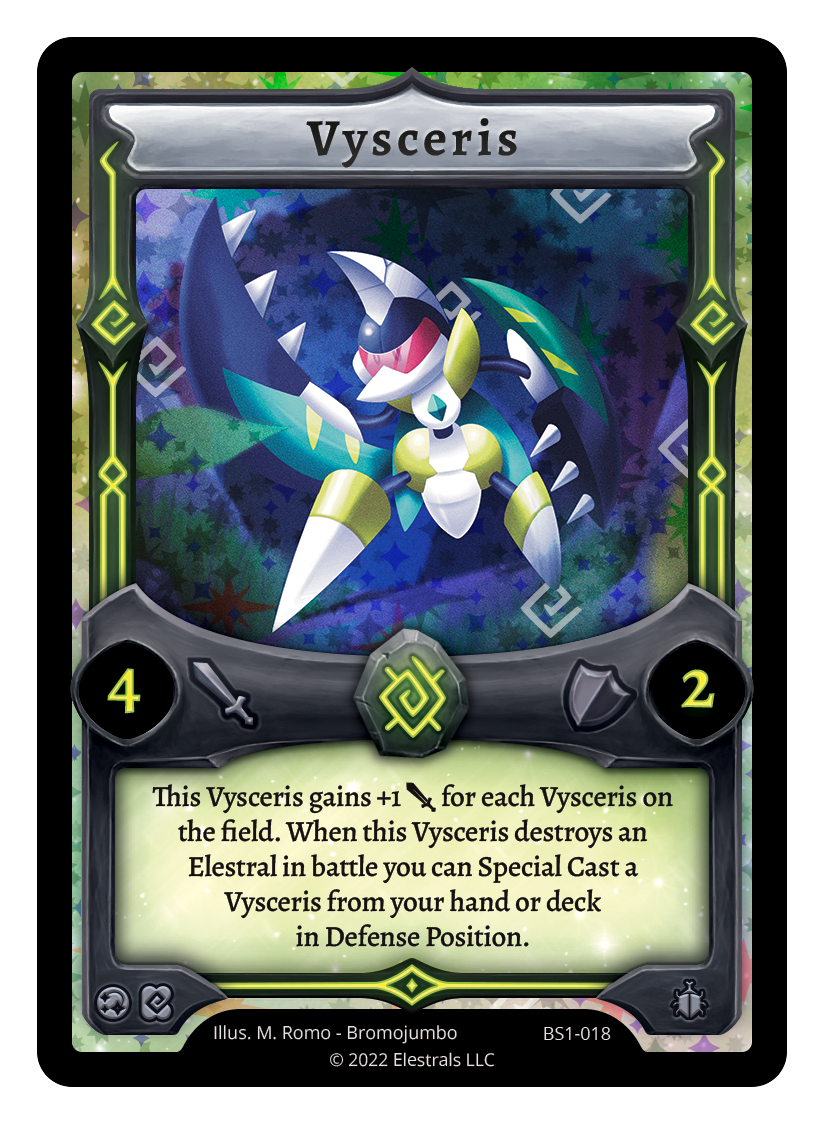


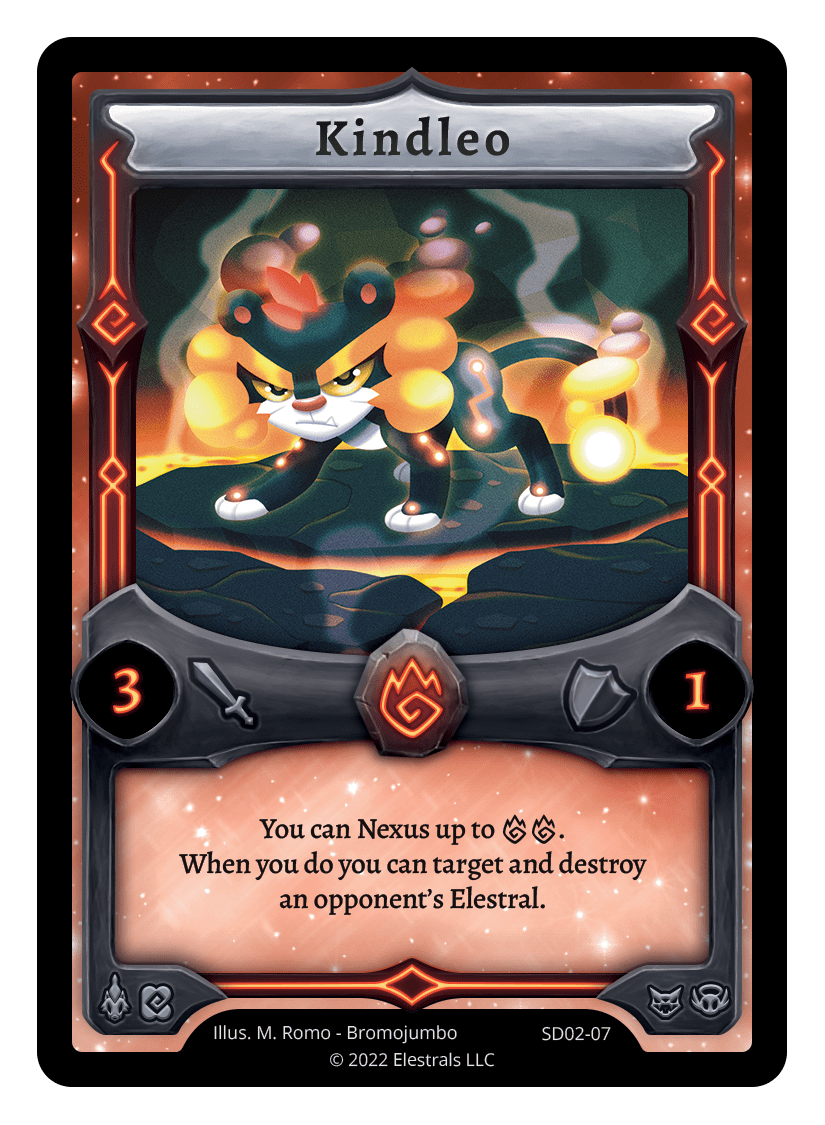










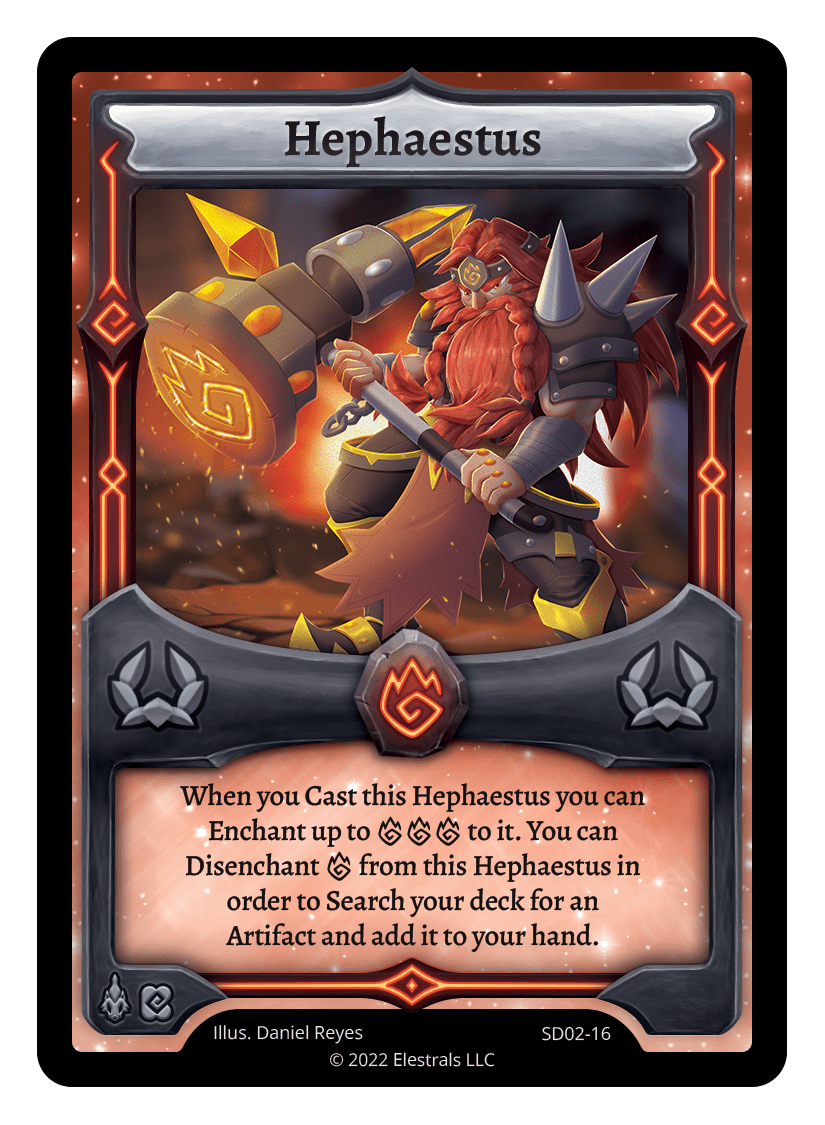








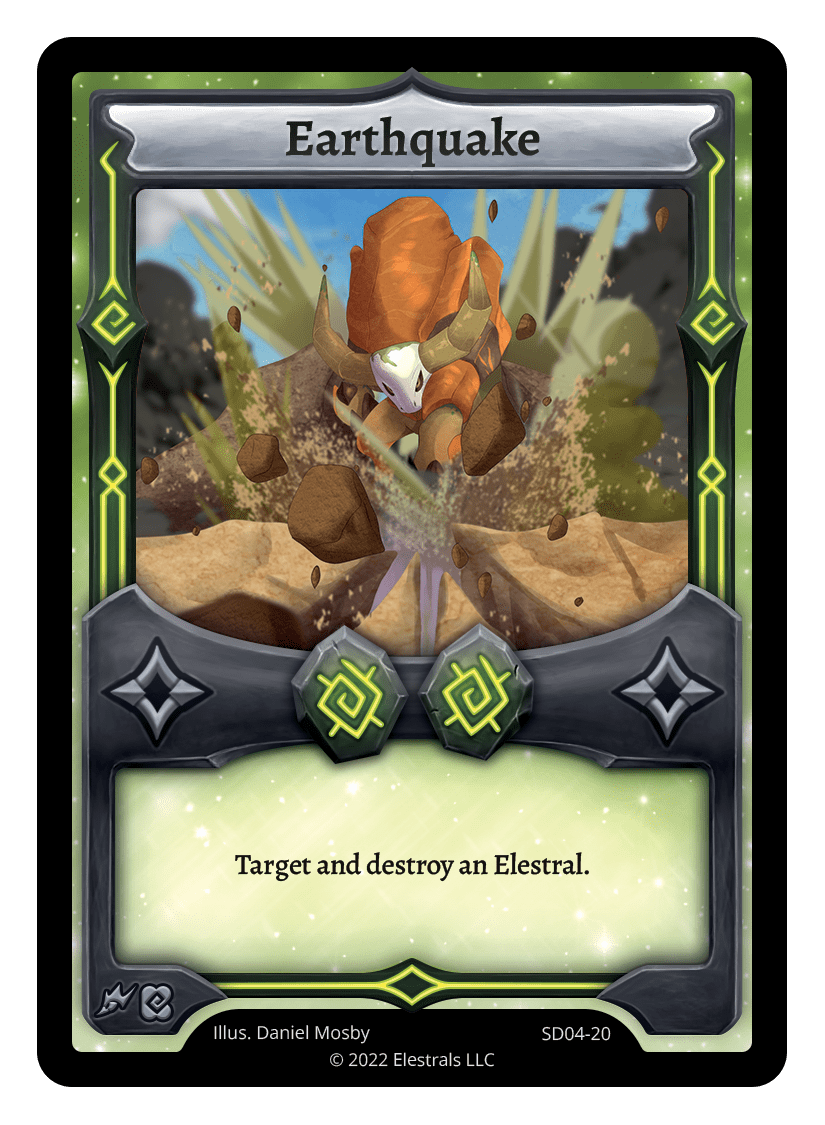
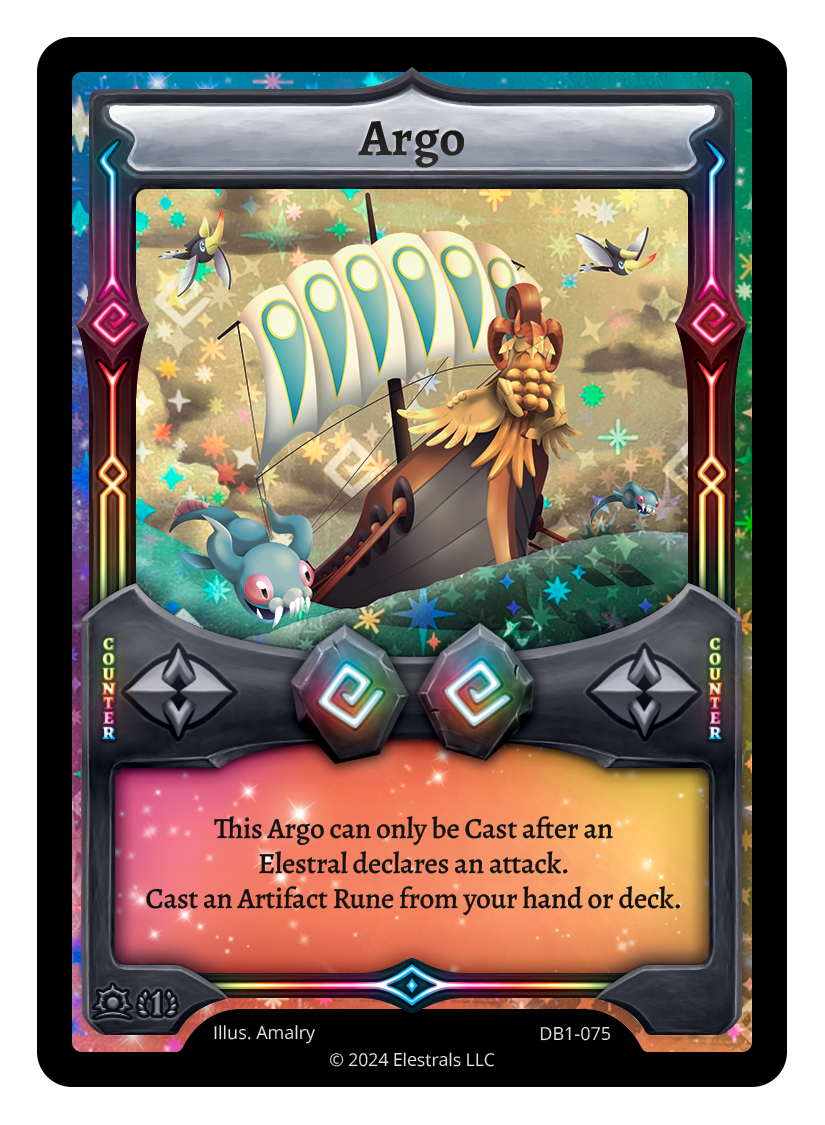




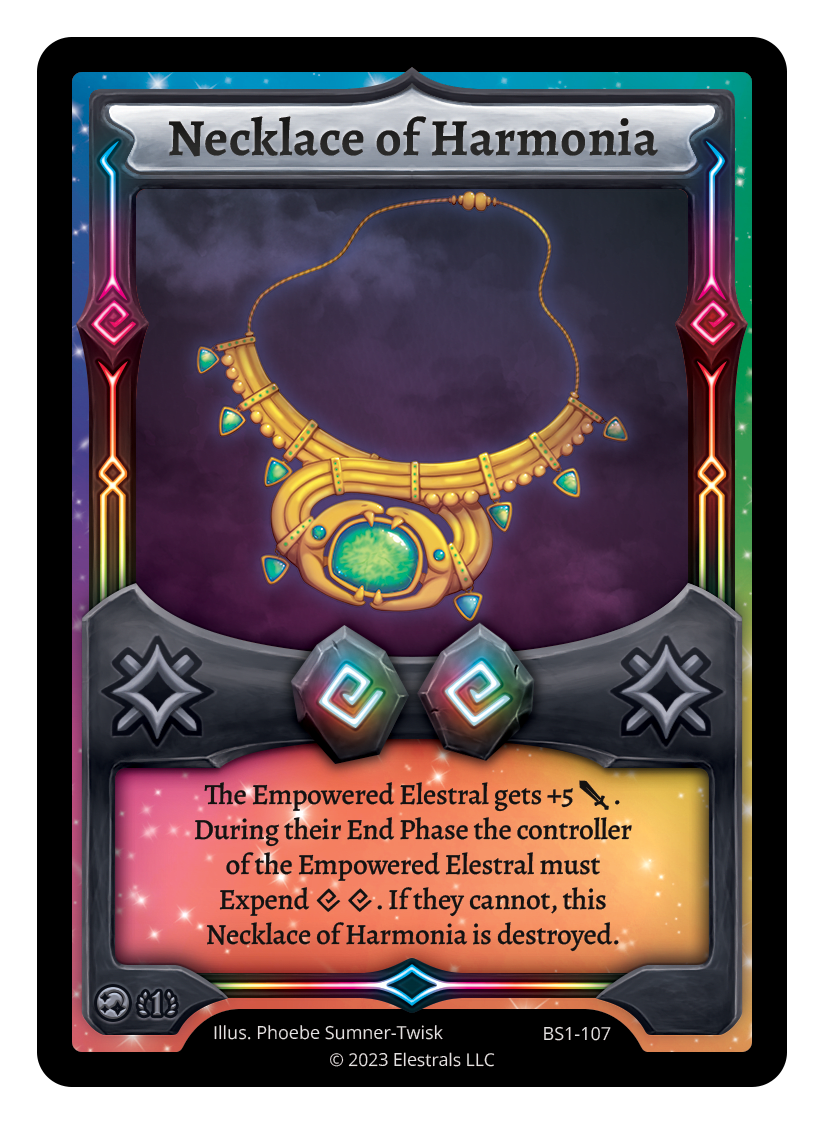
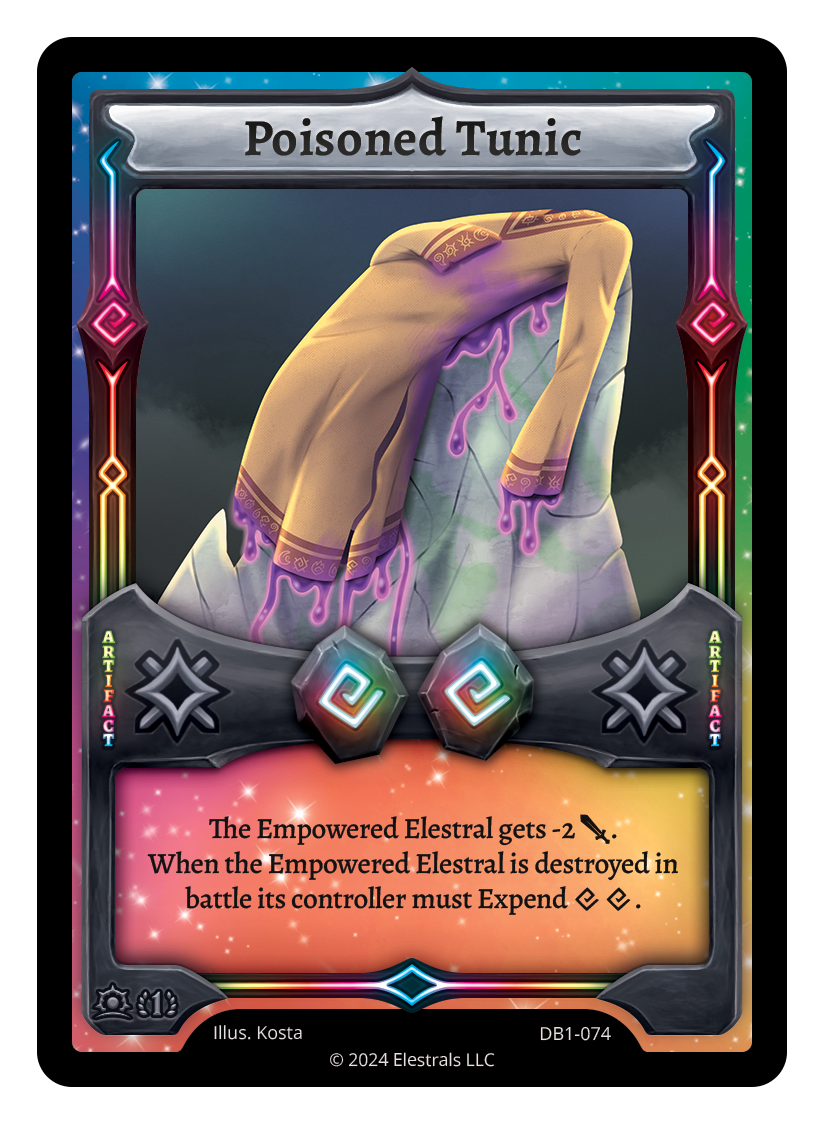


Spirit Deck


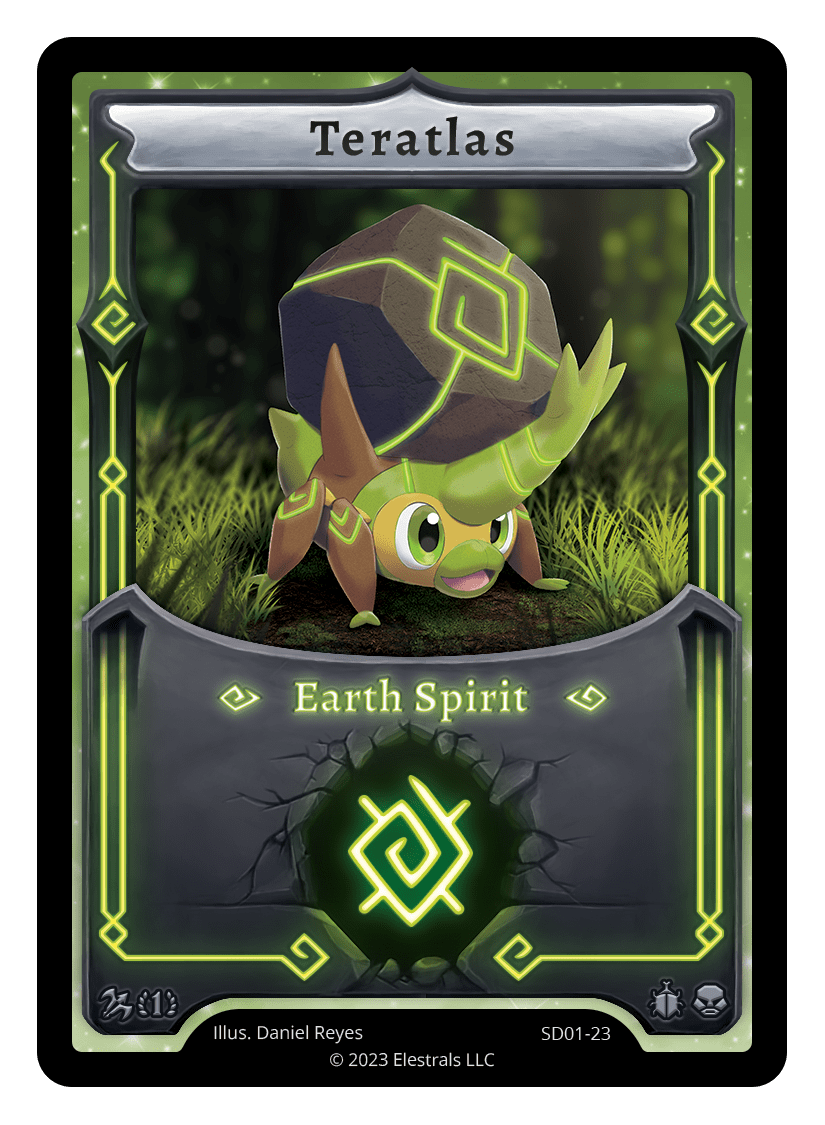







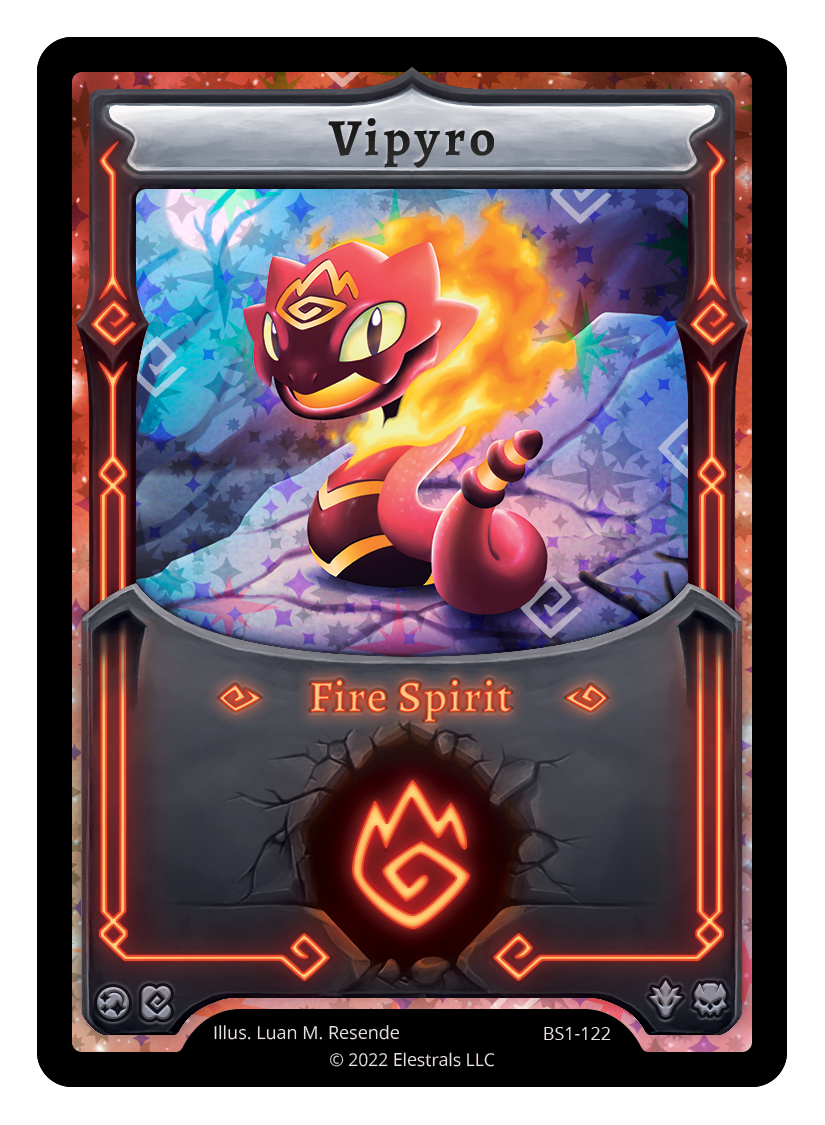









If you’re going to use any of the 2-drop immune options, Wasp is my go-to. In addition to the previous points, we do know that Wasp is looking to be getting support thanks to the Lifestream Starter Deck content name leaks in the form of new champ forms for Cyanectar and Wasp, a new Poisoned Nectar titled form, and even a new PTA titled from, so this should be a deck to keep an eye on moving into Lifestream.
The 2-Drop Exception (Shiveroar)
Shiveroar

Originally when reviewing the 2-drops for this article, I had made the assumption that all 2-drops with an immunity only had at most immunity to 1 kind of rune targeting. Shiveroar swiftly reminded me that the assumption was incorrect.
Released back in Frostfall, Shiveroar has a blanket targeting immunity against all opponent rune effects. This means that all runes that target are unable to hit this card as long as you control Mountains of Boreas, which means that it’ll be a minimum of a 9/7 with rune targeting immunity, making even combat options fall before it between its high stat line and sporting an immunity to Zeus, which all of the other 2-drops lacked.
Prior to the release of Firestorm however, this effect was lackluster as you would need to play an option like Jolten to find the stadium, then take 2 turns in order to develop an Elestral that could be outed by developing your own stadium over the Boreas. With Firestorm, we saw not only the new Shiveroar line, but also Brumalynx Champ, which cuts the turns needed down by 1 while also being an incredible Elestral in its own right.
Shiveroar has 3 main issues that can be exploited. The first is the aforementioned Stadium wars, as its targeting protection is tied directly to the stadium being active, so overwriting it with your own is generally enough to give you the room to out it. The second is the limits of its immunity, being exclusive to runes, meaning a cheap shot option like Boombatt can still clear it. The third, and in my opinion most damning compared to all of the options we’re discussing after this, is Shield of Achilles. For some unexplainable reason, Shield does not target the Elestral its bouncing, meaning that targeting protection means bupkis against it, and unlike all of the other wider target immunes Shiveroar has no in-card way to deal with Shield. This can be circumvented slightly thanks to Blizzard being so integral to Shiveroar’s identity now, but the option is still extremely costly both in deck building and spirit management, so be prepared to go low (as if Frost didn’t already go low enough).
Main Deck
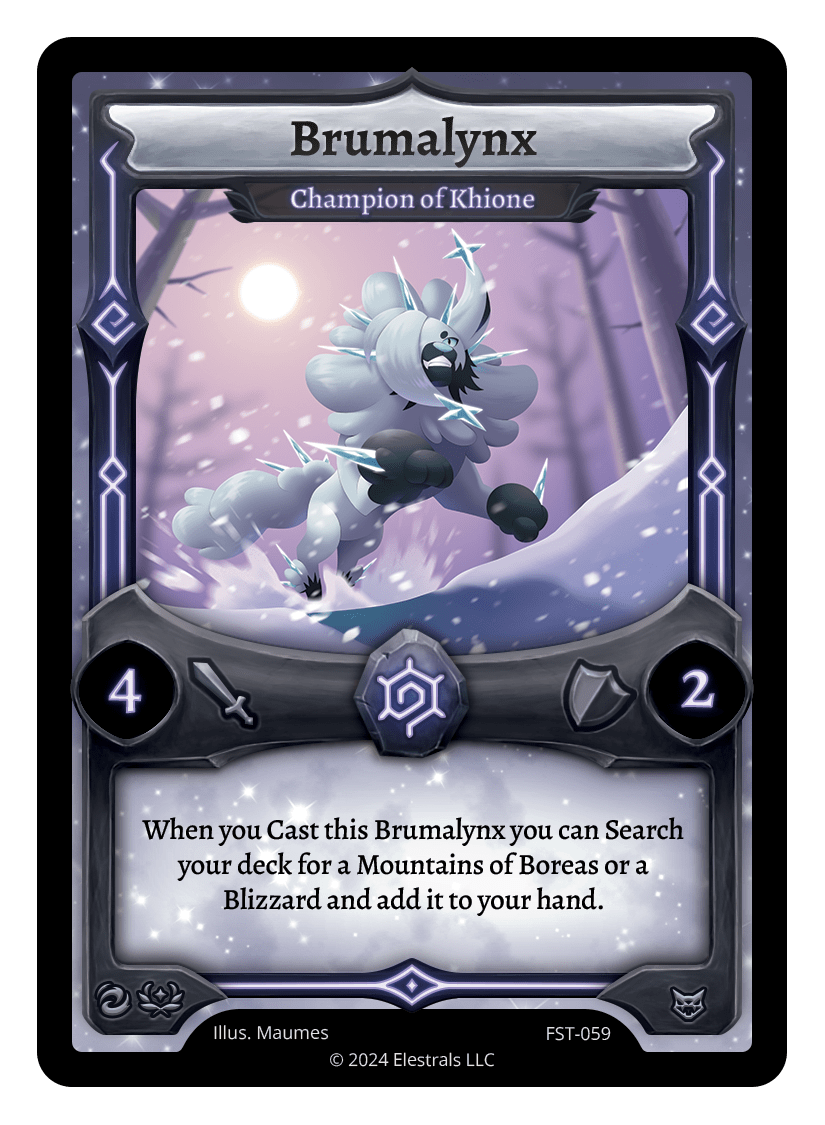


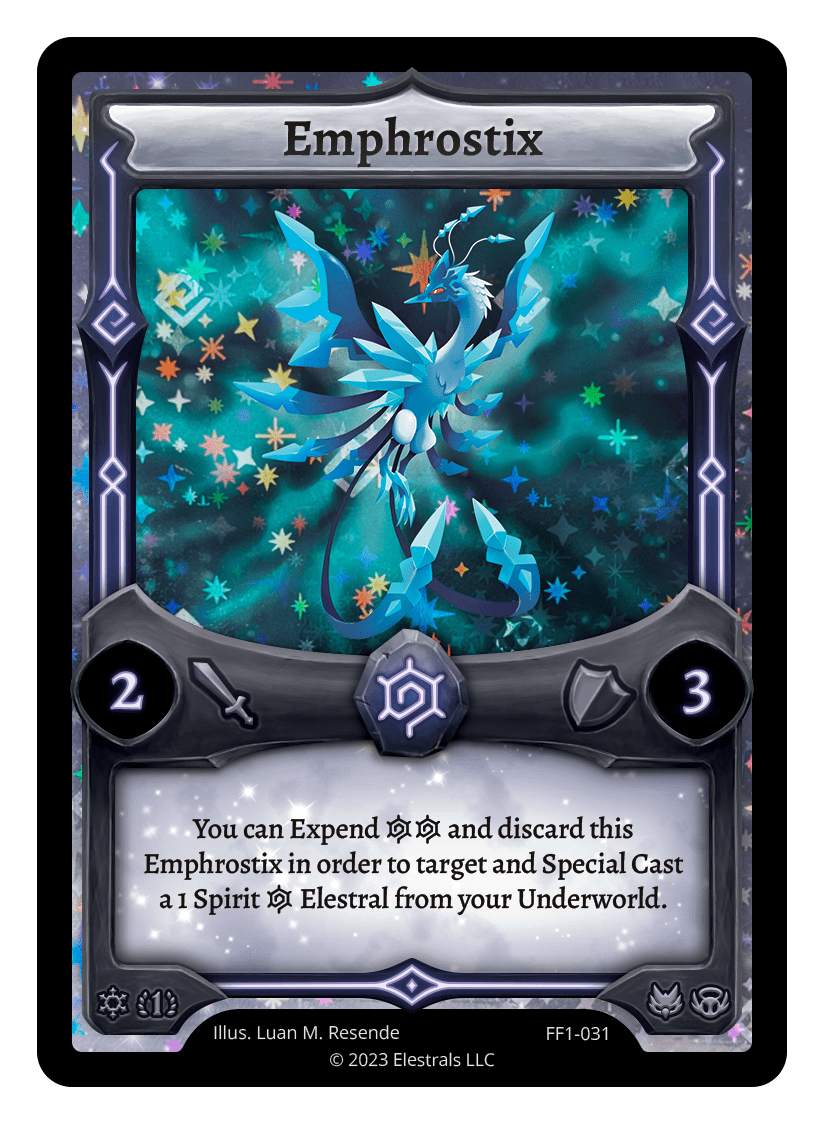
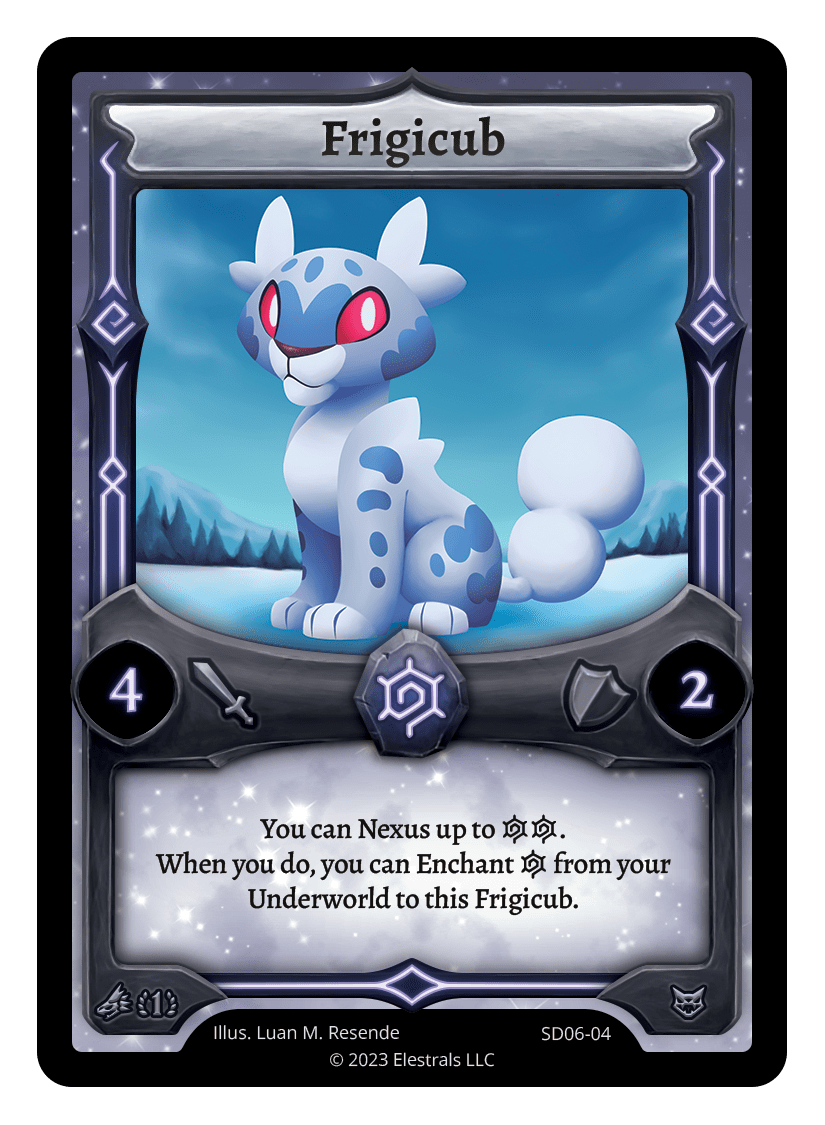

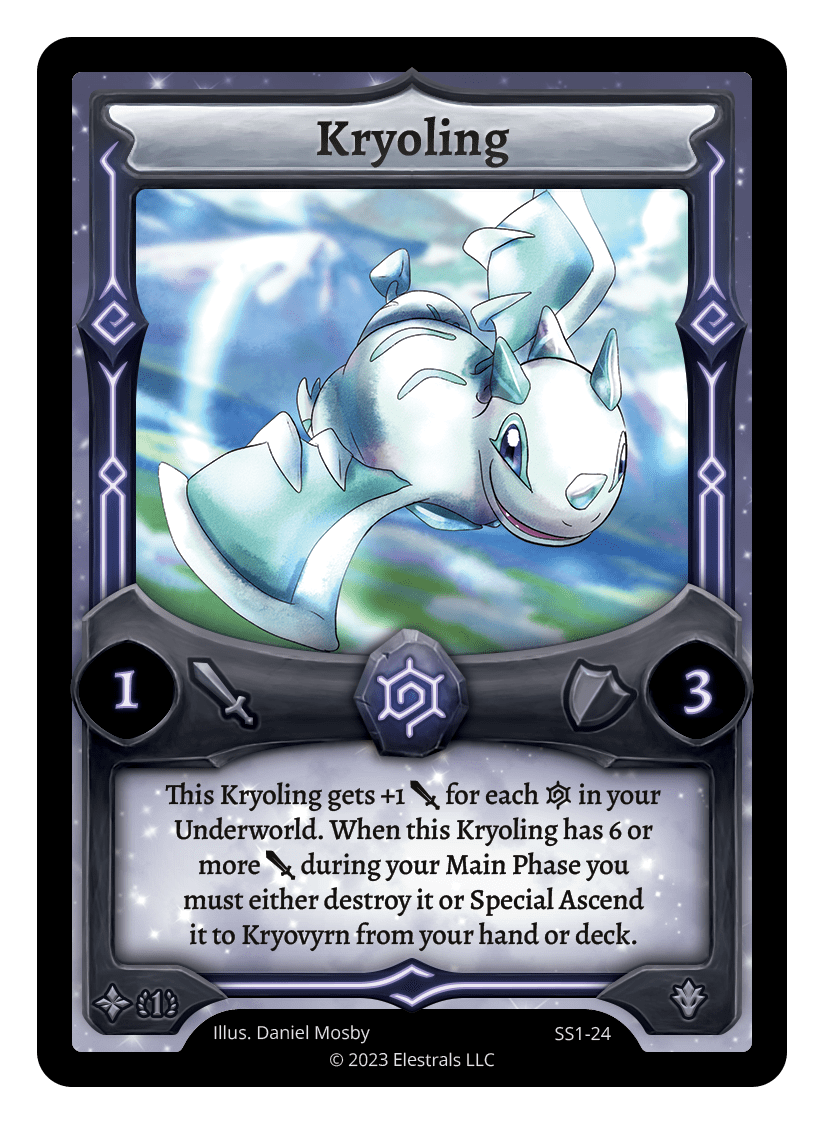








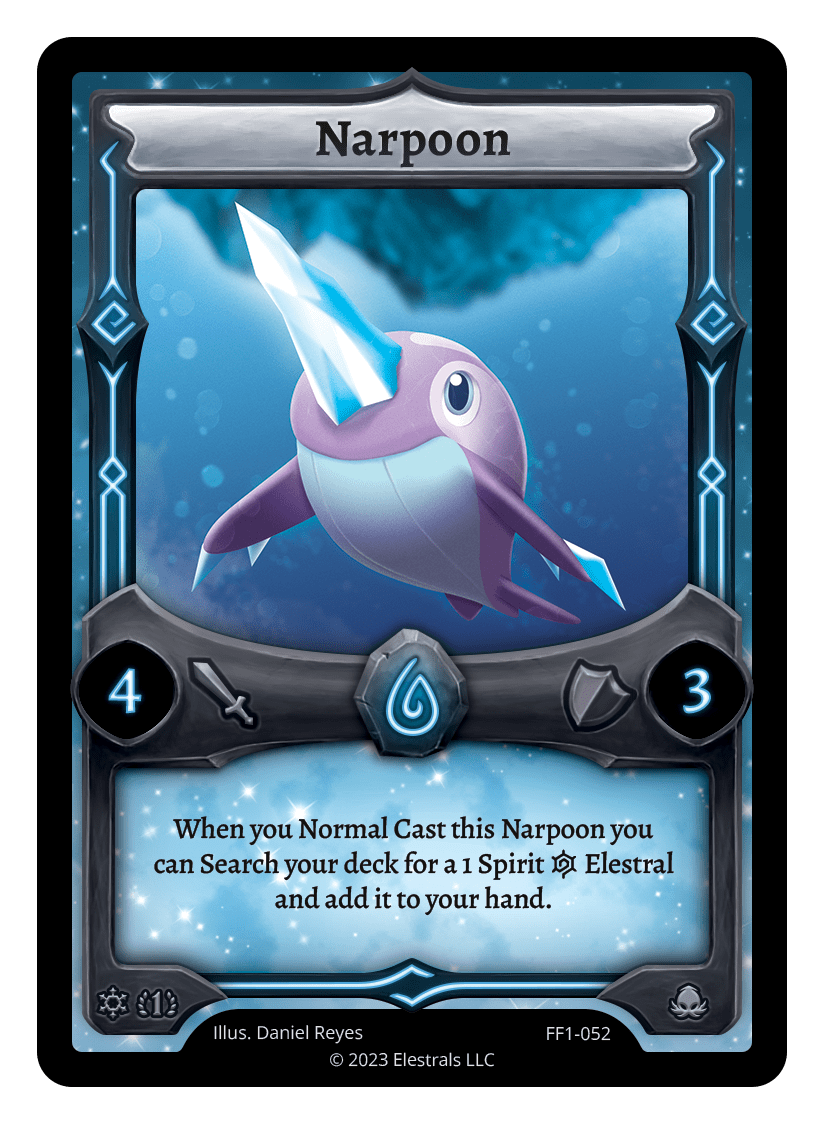


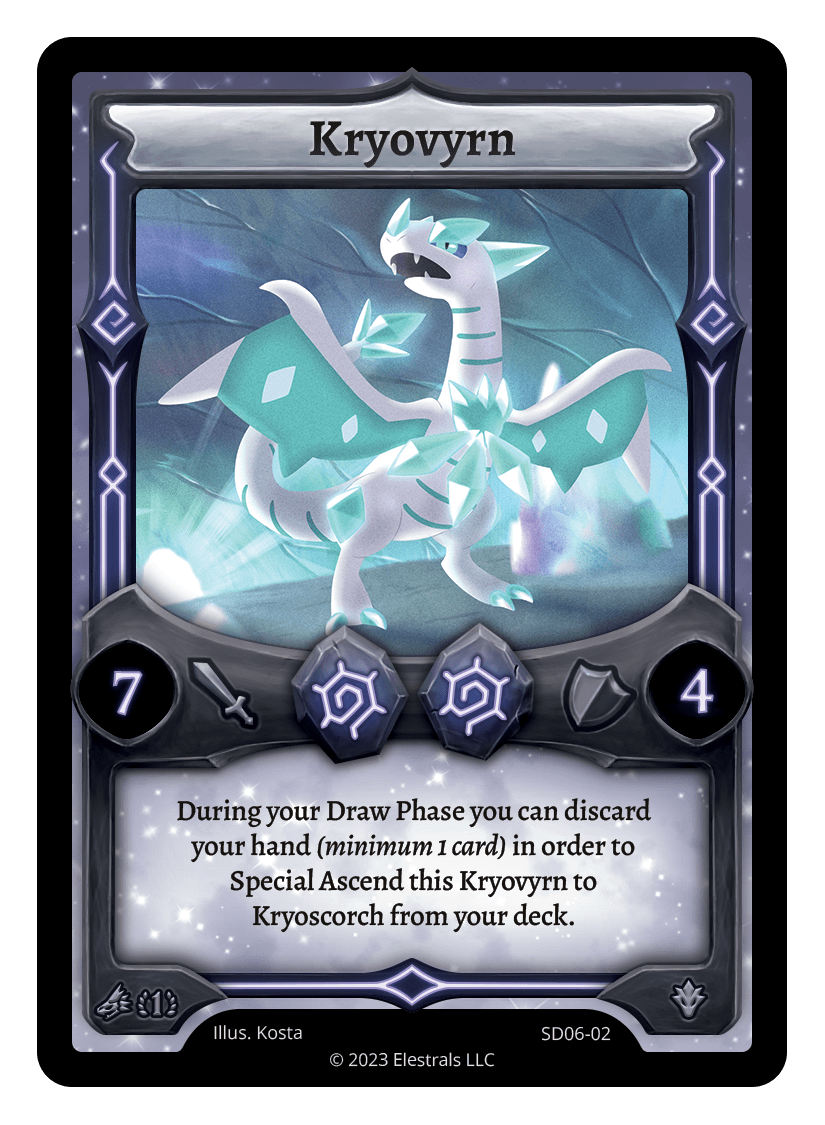

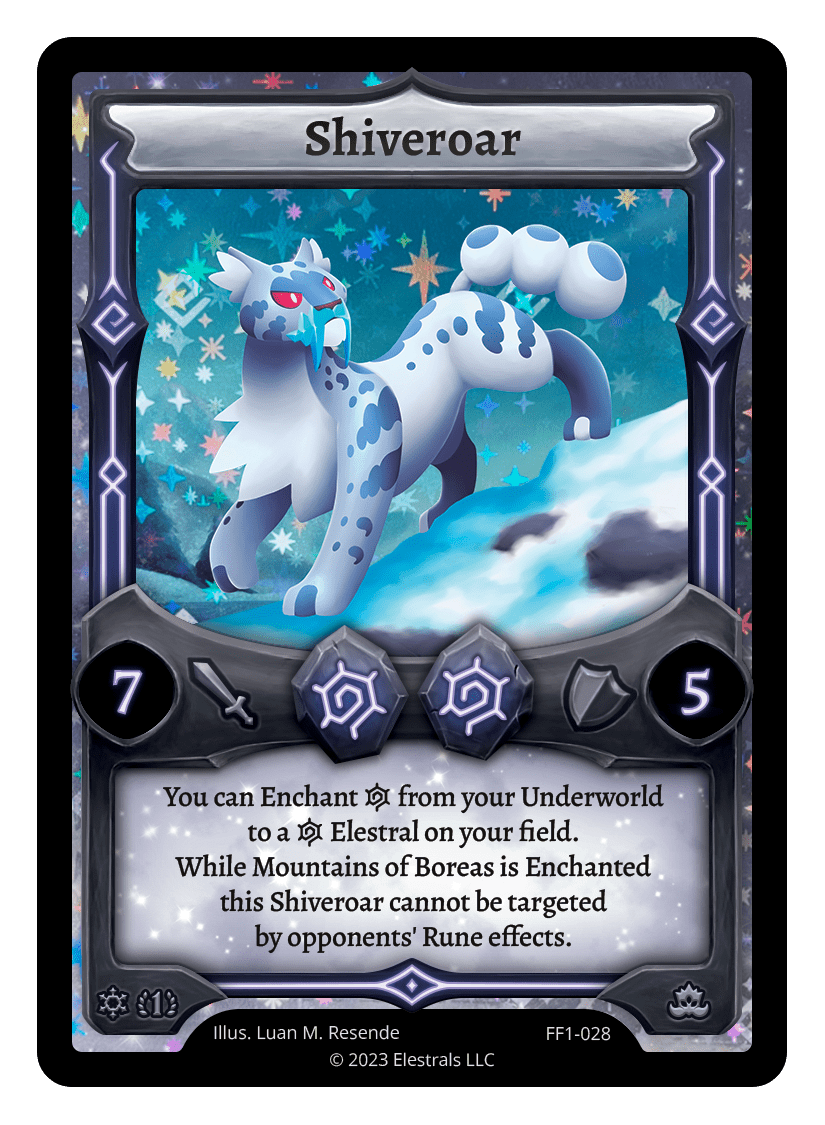

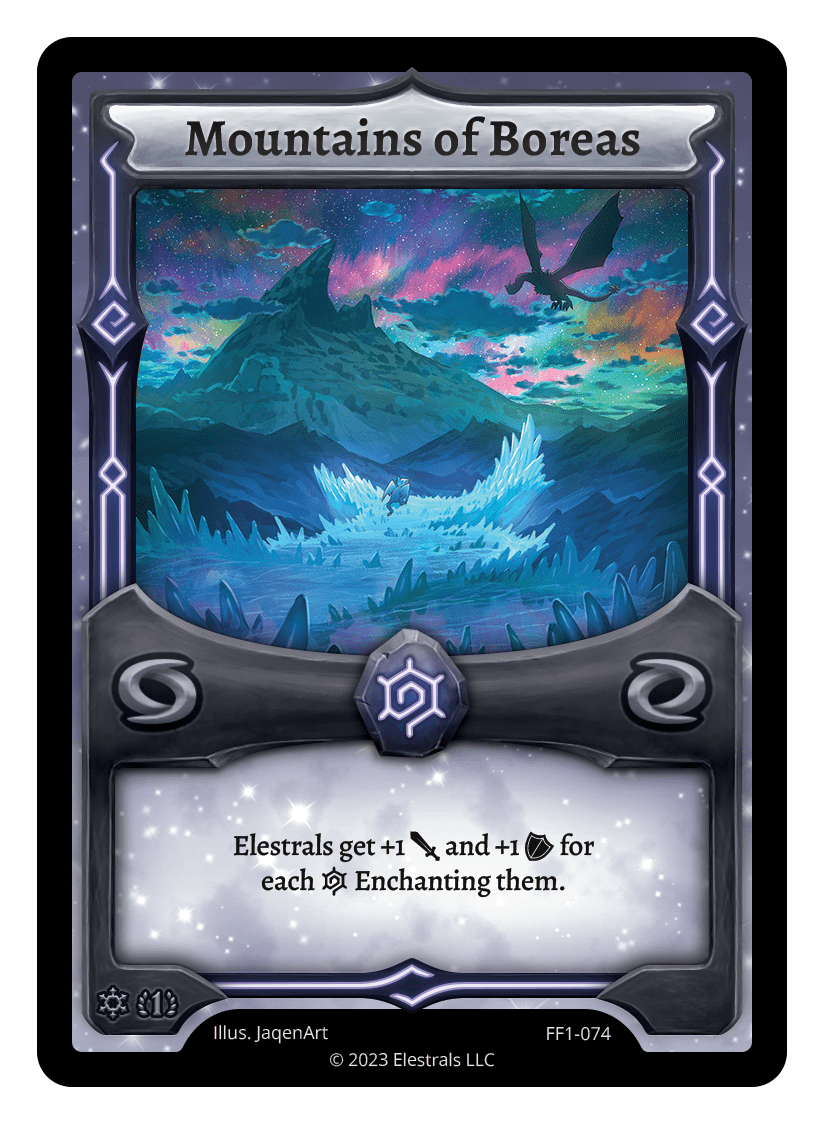

















Spirit Deck




















This is my (admittedly mostly lifted from Caleb's) current Shiveroar list. Main conceit of the deck once again falls into the style of Frost I've previously covered, but with Frigicub having the ability to keep your spirits in rotation, we want to have a nexus bank to play off of that doesn't sink our Stadium, so we're running an Argo line to facilitate it. Emphrostrix also pulls double duty here, able to cycle the Kryolings for big damage pushes or for putting a Frost body back on the board to ascend over into Shiveroar.
The Originator (Voltempest)
Voltempest
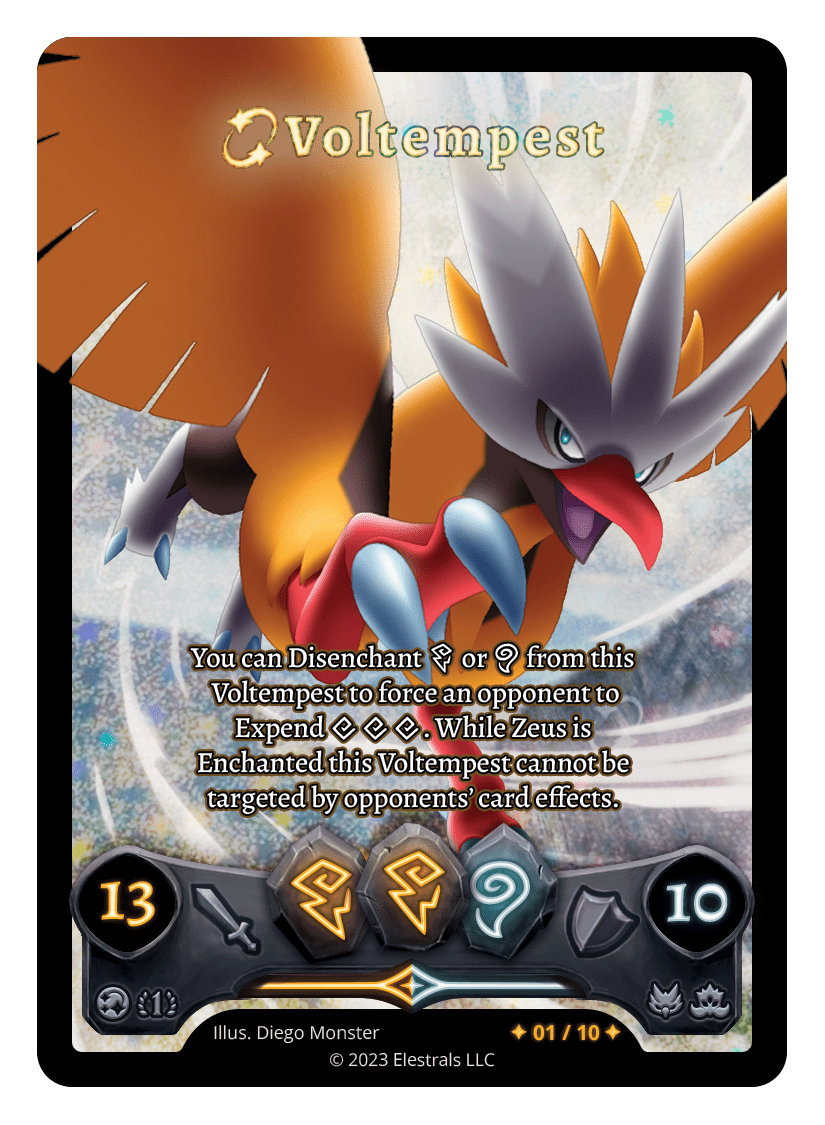
If you’ve ever played against me, whether in person or on Clash, there’s usually one deck that I’m piloting compared too all others, and that is Voltempest. Released all the way back in Base Set, Voltempest is unquestionably the Towers to end all Towers, having targeting protection from EVERYTHING as long as Zeus is enchanted and is able to disenchant a thunder or wind from itself to burn the opponent for 3 once per turn. This is the threat to end all threats if it hits the board, as most players do NOT play a reliable out for Volt, and by the time they can gather the resources necessary to out it, the burn has overtaken them.
Voltempest has a few ways of getting to the board, but the most common method is that of Griffuse. By ascending over any Thunder or Wind enchanted Elestral, a Griffuse paired with a Zeus in hand can give you instant access to Volt by playing Zeus for 2, nexusing one of the spirits to Grif, then ascending into Volt, which in turn can IMMIDIATELY detach the additional spirit for a 3 damage burn. The first time you experience this play; I liken it to a jump scare. There were 2 different opponents that I played against at the CardsHQ Open that did NOT know what Voltempest did, and waiting until its on the board is not the way to find out. If you see the Grif come down, you had better have Gorgon’s Gaze already locked and loaded in the backline to slap the Griffuse with and stop the ascension play, because if the Volt hits the field the game’s effectively over.
In formats where Zeus is everywhere (like Set Championship Format for example), another option you can pursue is that of Hermes. Hermes by disenchanting 2 winds can dump a Carryon Champ from deck, which can then revive itself using one of the spent spirits. This gives you both an immediate ascension point for your Griffuse and a Divine to nexus from for Griffuse’s effect, meaning that with Hermes, Voltempest can be a no-set up required play. This line is generally recommended only if you have abundant access to Zeus, your opponent regularly leaves Zeus on board (because for some reason Volt counts the OPPONENT’S Zeus too) or if you’re doing a more combo oriented variant on Voltempest.
The third, and probably least common to see, is the hard ascension into Voltempest directly. This will generally only happen if you’re in a much slower game state, as the most common line that I’ve seen happen is a re-enchanted rabbit that stuck the turn goes right up to Big Bird. This still requires you find Zeus for the protection, and it means you won’t get the burn off that turn, but it does occasionally happen. My most common way of achieving this has been Chrysoar Champ, who when ascended into off of a Soarlet Champ that searched it can use whatever spirit it wants to (since the Soarlet Champ already had the wind on it), allowing the attachment of a Thunder (THIS WAS WRITTEN BEFORE THE RECENT RULING CHANGE, NO LONGER VALID). The other option I can see being potential is Griffuse Champ, able to special ascend over any Champion of Zeus, though the line-up right now is, in my opinion, too sparse of good bodies to pursue as a good deck choice, but that could easily change with Lifestream.
As for counters, while the best option to stop a Volt is to stop it from EVER hitting the board, there are a couple ways to out it once it’s on the board. The first and only real way you have of stopping it on your own agency is to out both the Zeus and then the Volt. Because this requires targeted Face-Up Rune removal, your options are extremely limit, basically down to Thunderstorm for most decks, and even then, most decks don’t play it currently, and then you still have to have a way to remove the Volt once its protection is down. The other way is the aforementioned Shield of Achilles, but unlike Shiveroar, there IS a way around this for a Voltempest player, which is to simply not attack. By trading 1 spirit for 3 every single turn, your opponent is put on a clock that does not require you to attack even once, but for optimal play lines, you can move to attack with Voltempest once the opponent’s spirit deck is at 2 or lower, as Shield cannot resolve against Volt unless they have at least 3 spirits left to expend.
Main Deck









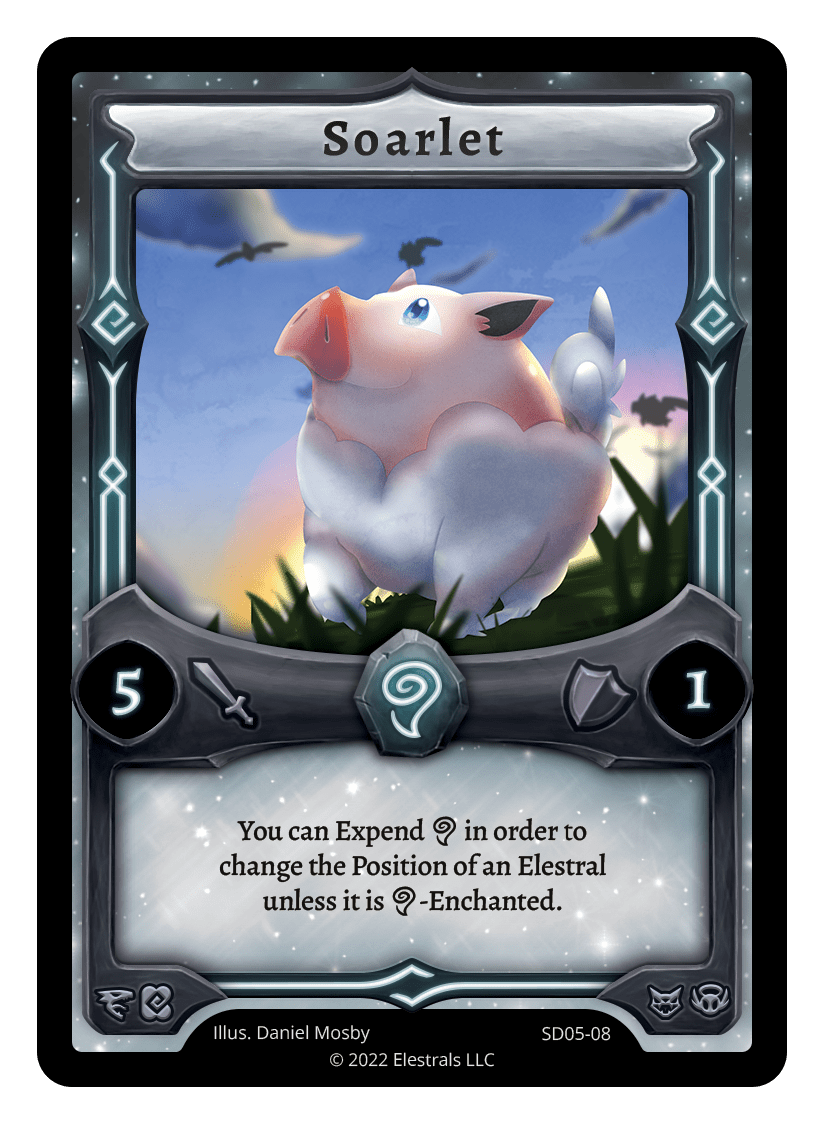




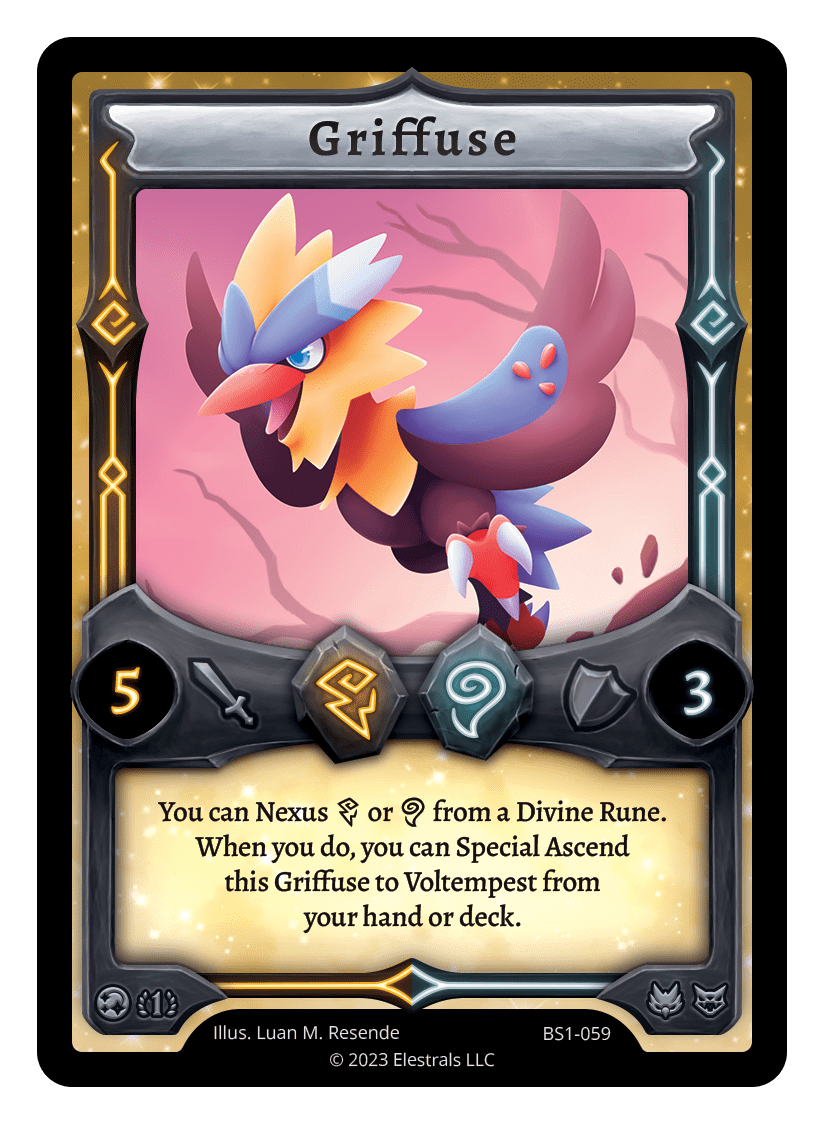



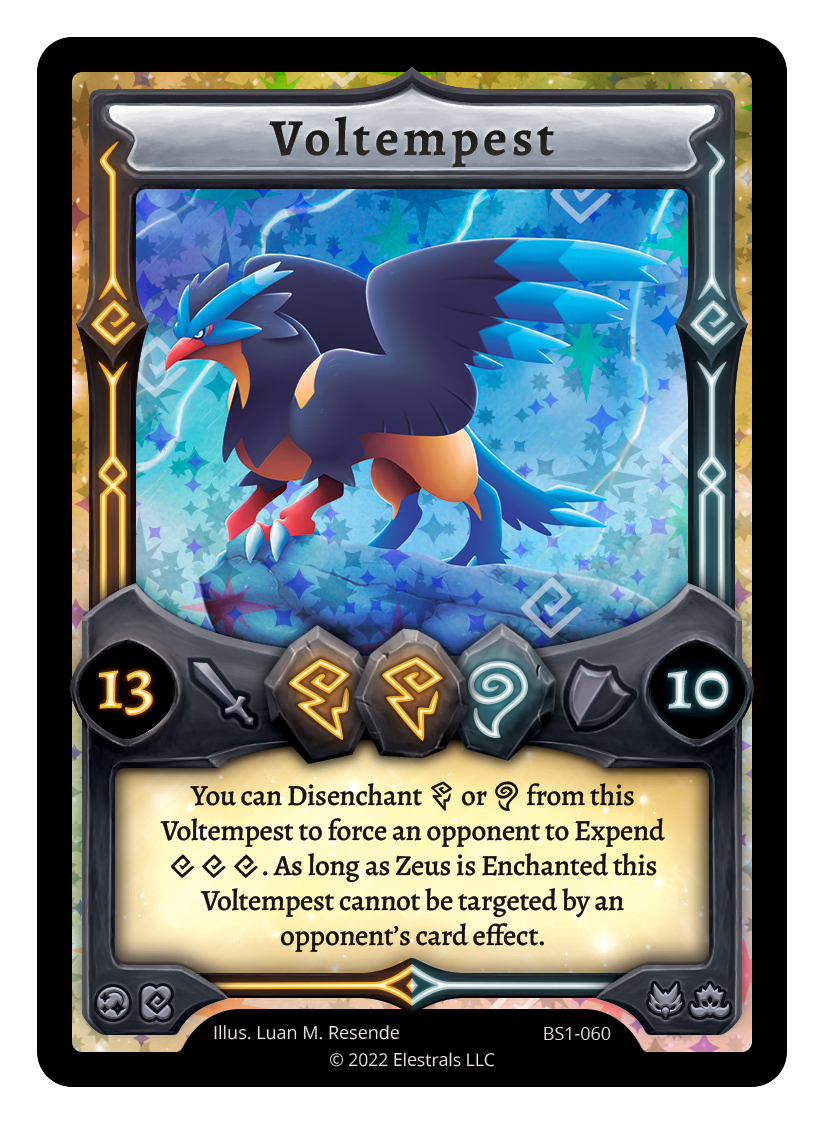



















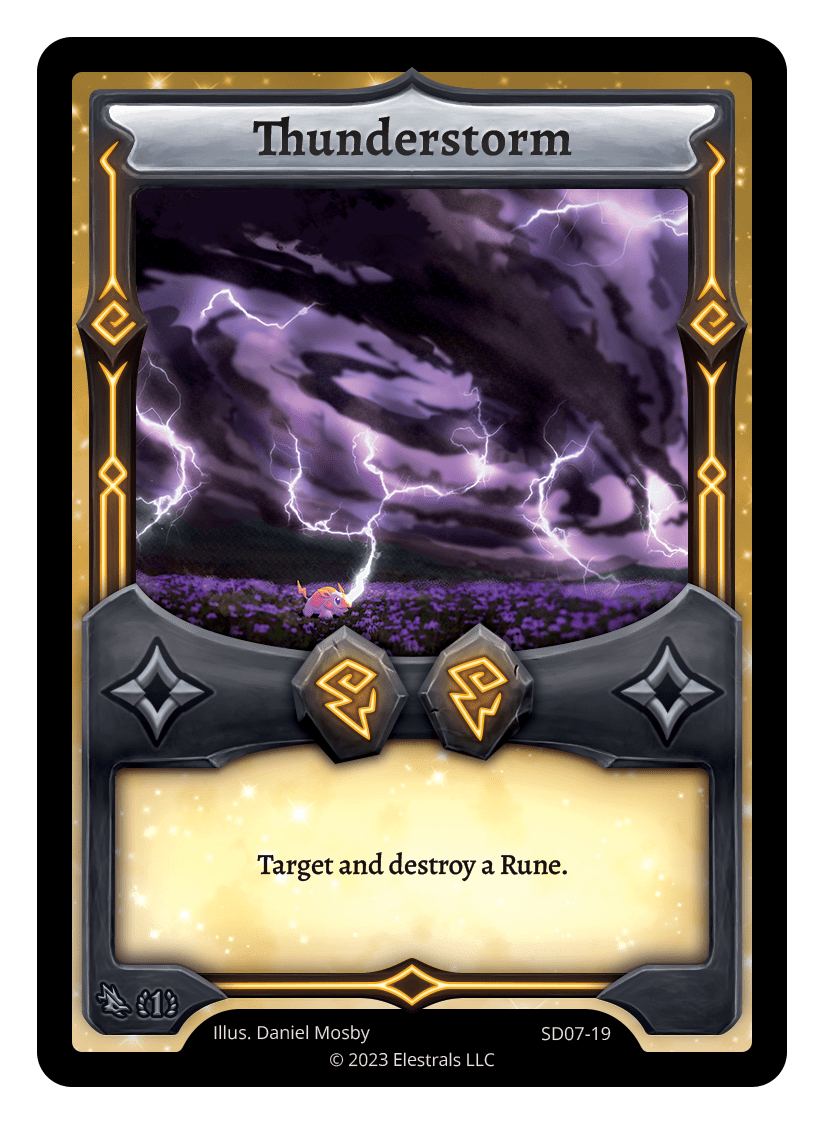

Spirit Deck




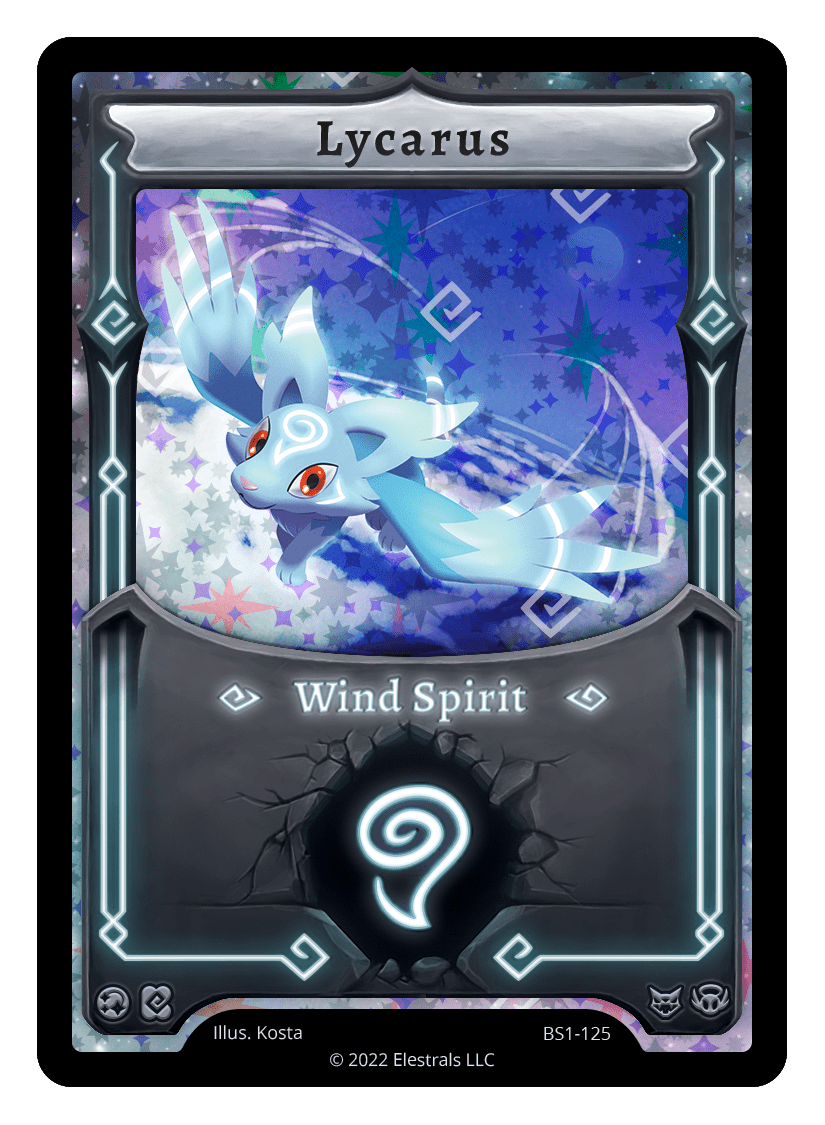















This is my current list, modified from my list that I used at the CardsHQ Open. I’m still heavily torn on the best way to build the deck these days, but Thunder never seems to disappoint when it comes to the value of good stuff cards.
The Noob Trap (Chronodile)
Chronodile
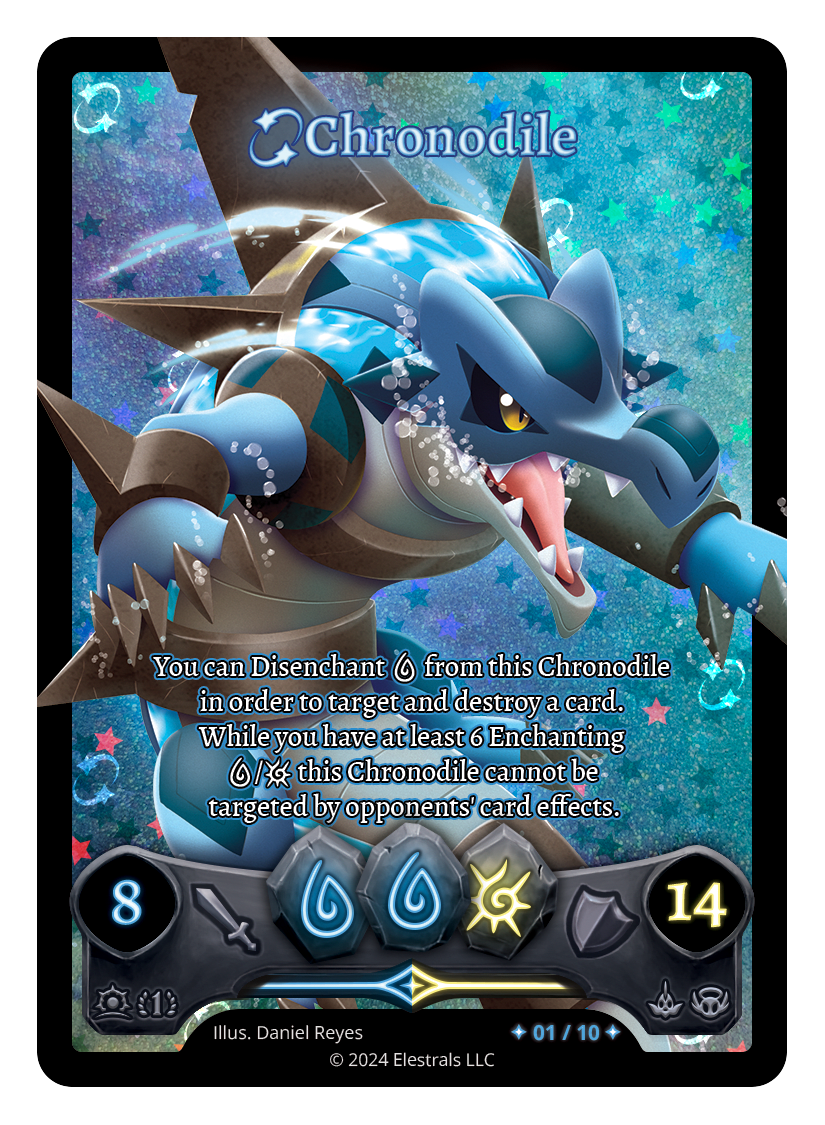
If you’ve been following me since Daybreak release, you’ll know that I’ve been working on making the Croc work for the longest time, but never was able to make it tick quite right using all the various water nexus strategy pieces. Turns out the answer was NOT in water, but was rather in the solar side, specifically in Exaltus. By sticking Exaltus with an Argo in the backline, you can force a nexus to search for Gnomodile, who in turn can get you 2 more spirits as you ascend into Chronodile, in a very similar manner to how the Griffuse line works for Voltempest, using just itself.
Main Deck
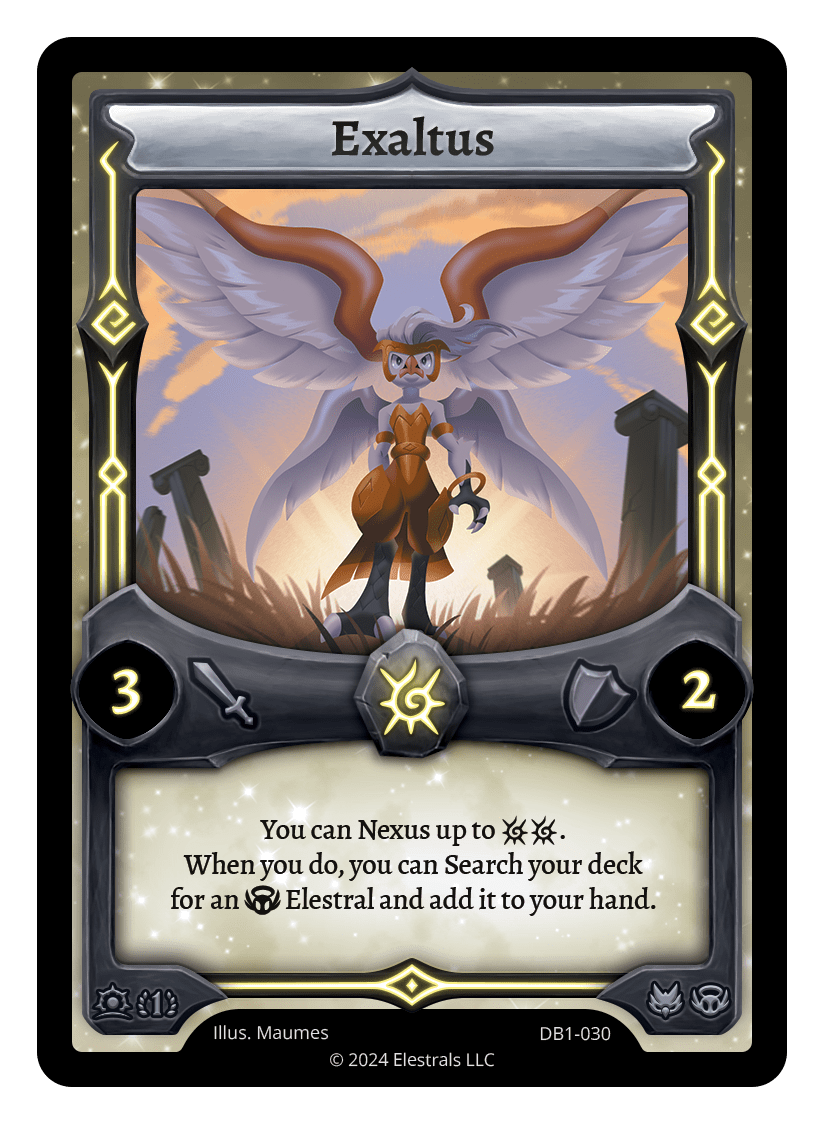








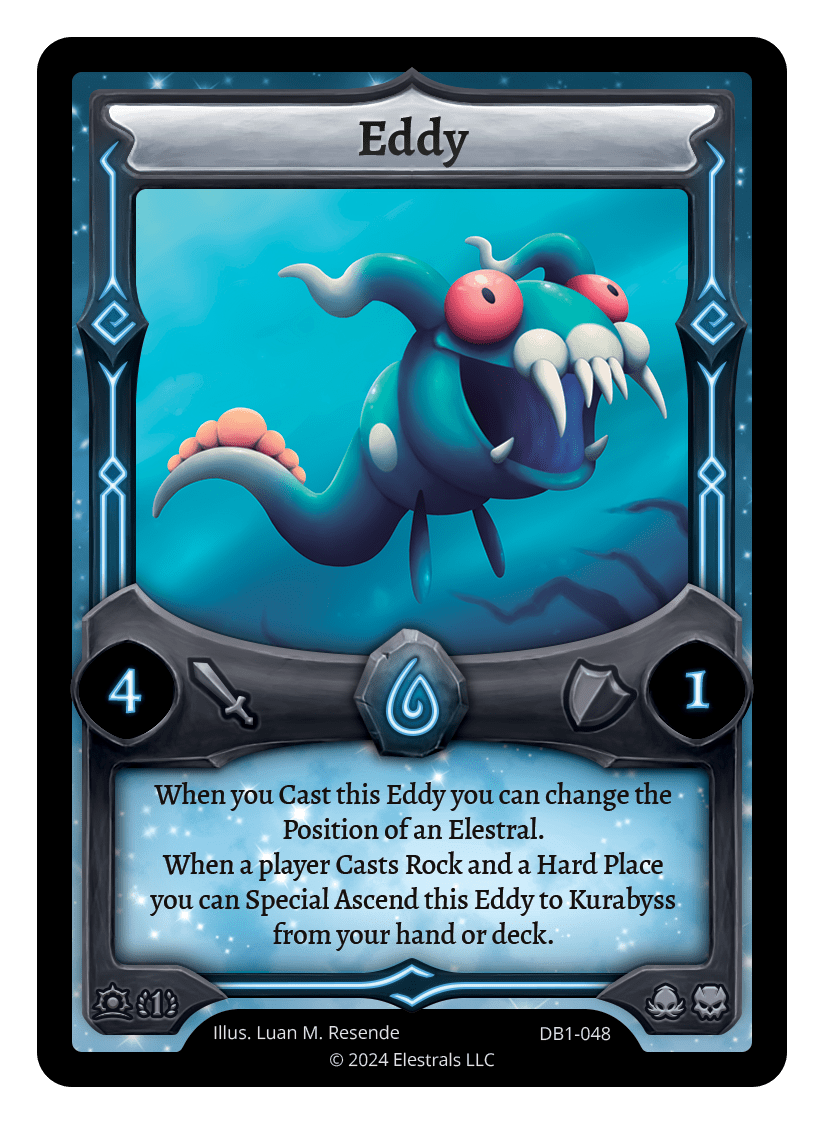




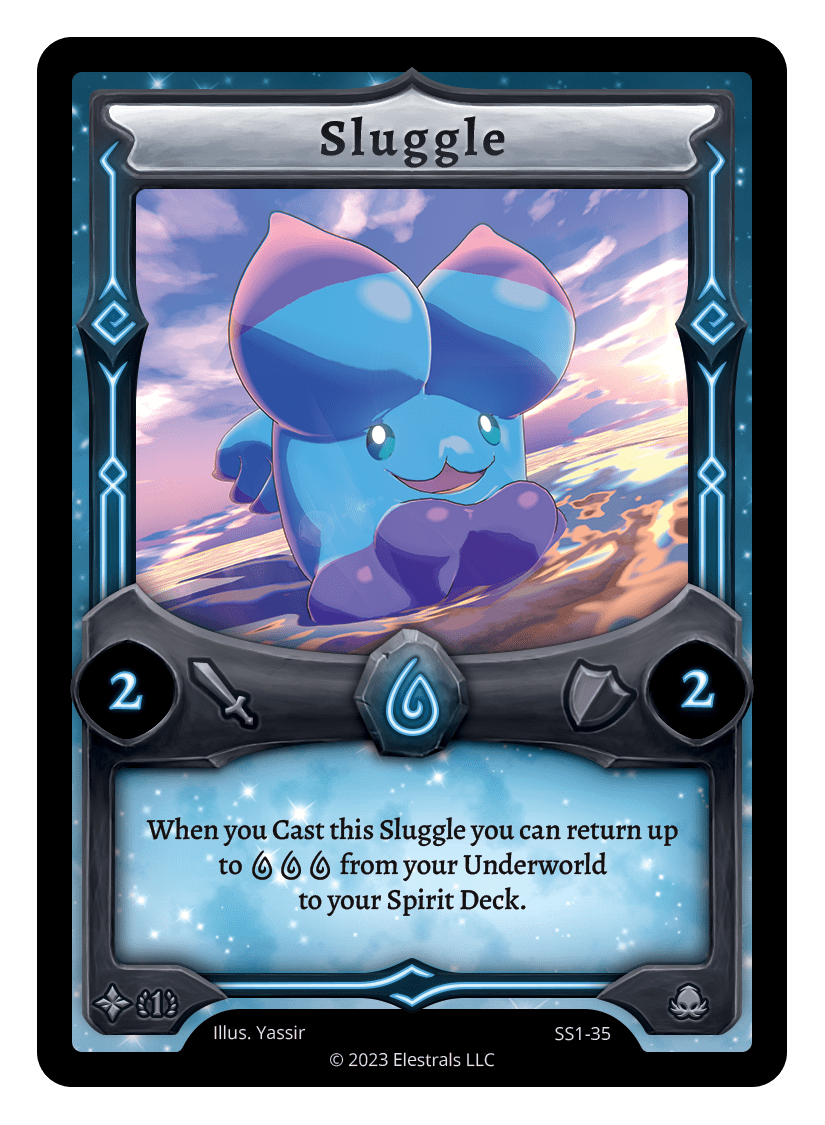


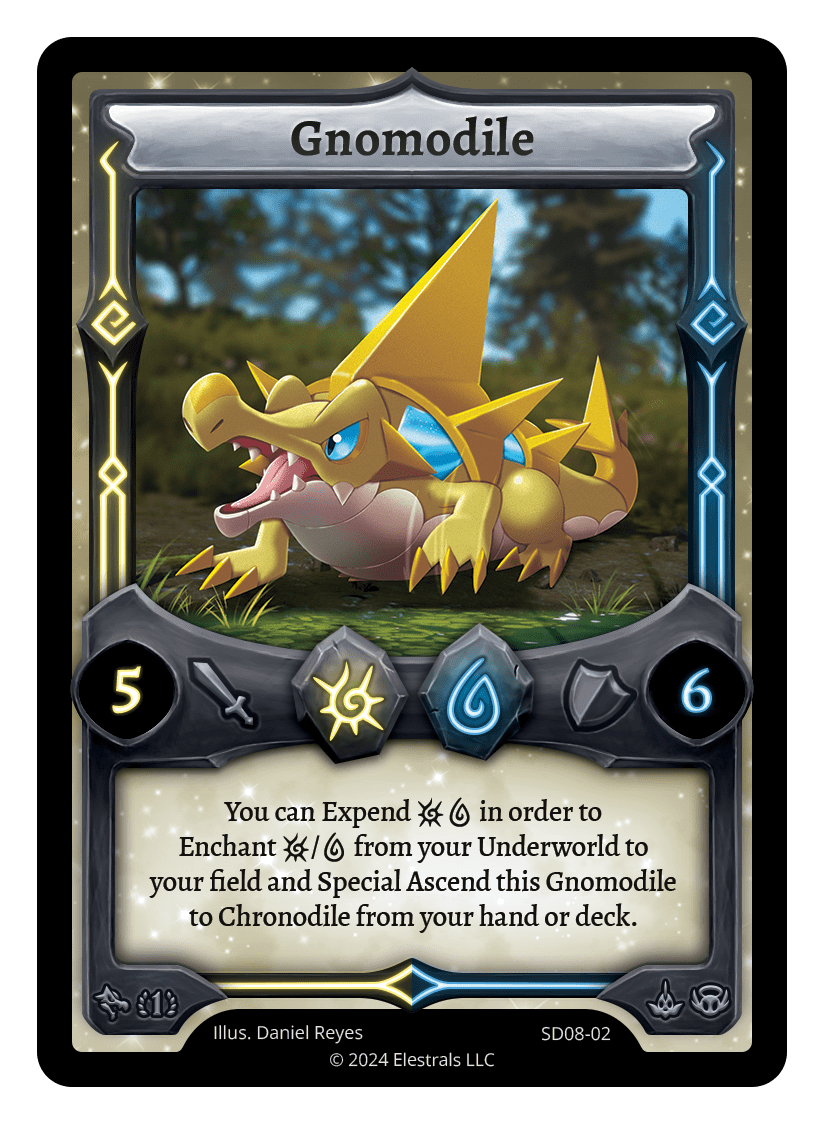
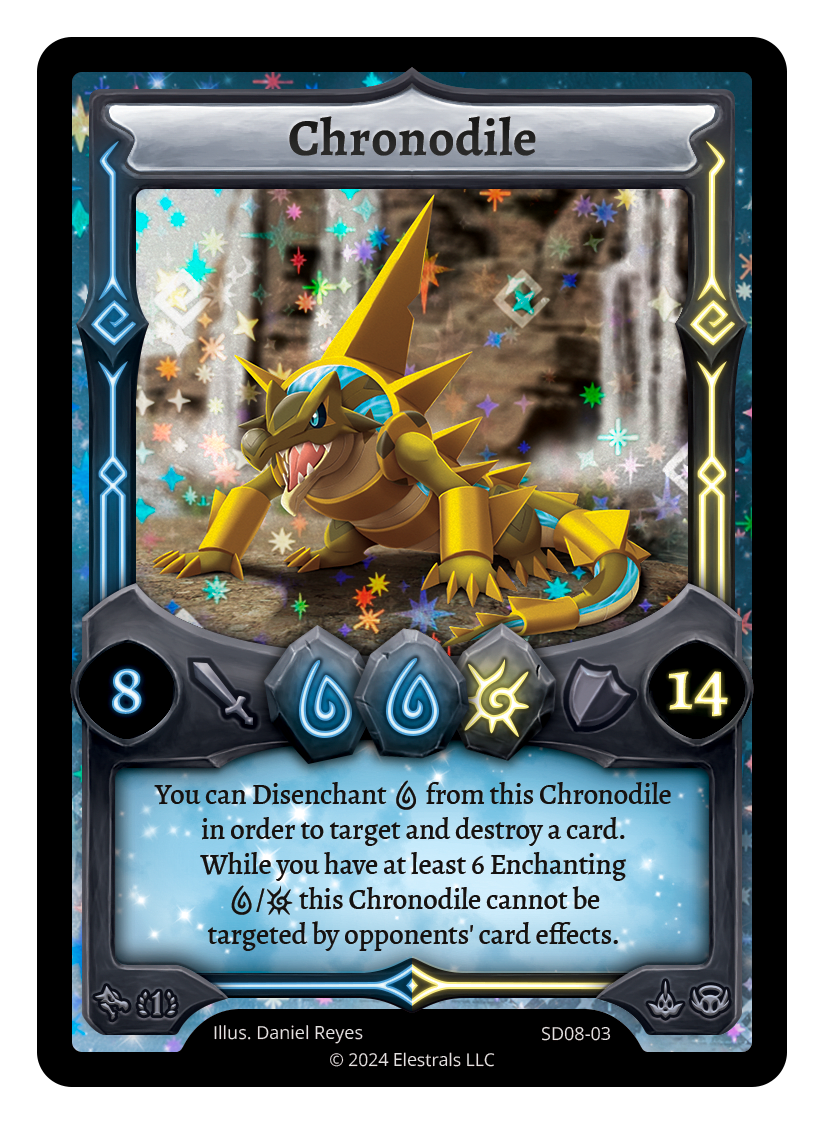






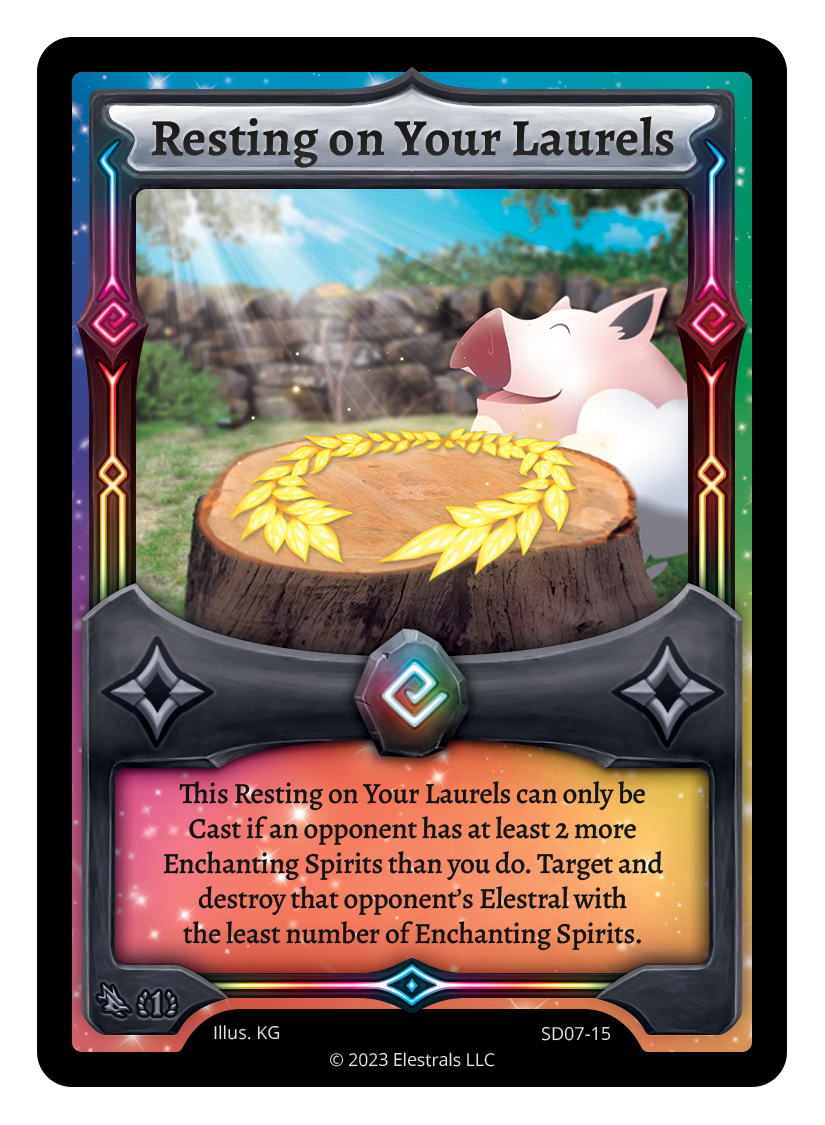














Spirit Deck




















Here's my current list for Chronodile, and a couple notes probably need to be addressed right away. For starters, no more Poseidon. Its been a long time coming, but after a particularly awful bout with Poseidon at the Giga-Bites Pre-Premiere, I’ve given up on using Poseidon as an ascension tool for 3-drops unless the cards are specifically built to be used with Poseidon as the linchpin. Instead, we’re utilizing Gnomodile to get all the way up all by his lonesome. Another concept I’ve been kicking around is the potential usage of Bubbloon Champ from Shattered Stars, but I’ve not tested it enough to recommend at this juncture.
Chronodile gets the same level of protections as Voltempest did, with targeting immunity from everything. The difference being its protection is directly tied to the number of Water and Solar spirits on the board at any given time, so realistically we’re trying to get all 6 for the requirement under the Croc ASAP. Unfortunately for the Croc, it does not have a way to deal damage without going on the offensive, with its detach popping a card on the field instead. Because of this, and the fact that Shield is once again the best way to remove it, you should always be prioritizing backrow with its pop, specifically newer backrows unless you have a read on a previously set shield.
I wish I had more to showcase for Chronodile, as it truly holds a place in my heart, but for now the Croc is just not worth the investment to go into it in my opinion. Hopefully the new Chronodile pieces in Lifestream change that.
The “Not a Towers” Honorary Towers (Pharogeist)
Pharogeist
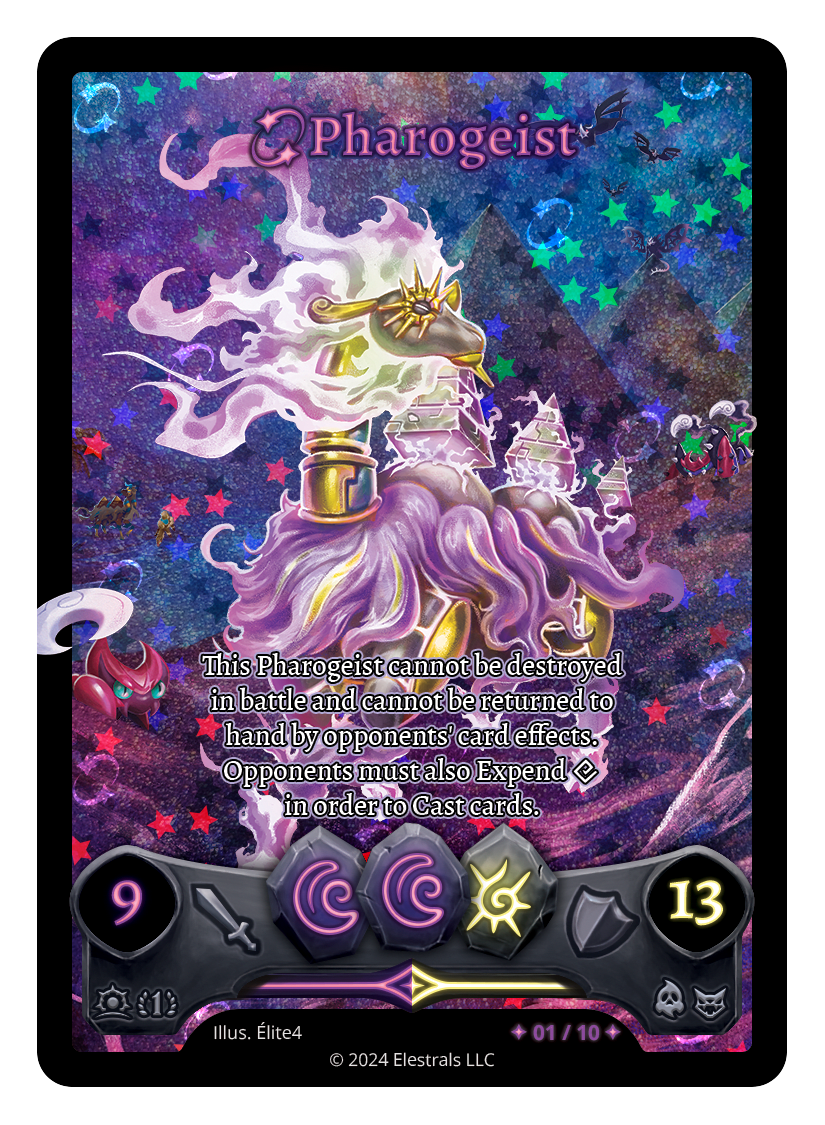
Now a quick disclaimer: Pharogeist is not a Towers in the same vein that we’ve covered so far but is definitely worth discussing in the same article because of one specific detail: Pharogeist is immune to Shield. As we’ve discussed a bunch at this stage, Shield is the downfall of most of the Towers Elestrals, and having an immunity to not only that, but battle destruction too effectively necessitates the opponent to have one of 2 answers: PTA on the cast of Pharogeist or Earthquake after the fact. There’s also the option of combining Gorgon’s with Shield in a specific manner on attack declaration, but there’s another reason you wouldn’t want to do this…
Pharogeist has one of the most hated card game effects tied to its body: Taxes. Every card the opponent plays requires the expenditure of an additional spirit, which in the case of the Gorgon’s and Shield combo out previously mentioned means the opponent is going to invest 8 total spirits to just put the camel back in the hand, and that’s a TERRIBLE trade. This card is so powerful that on the approach to Moonrise, Pharogeist was limited due to the potential of any Elestral being able to become the camel via Full Moon into an ascension. With that said, even at 1 copy, there’s still a viable way to play the deck, and it shockingly is similar to its contemporary Chronodile.
Main Deck

















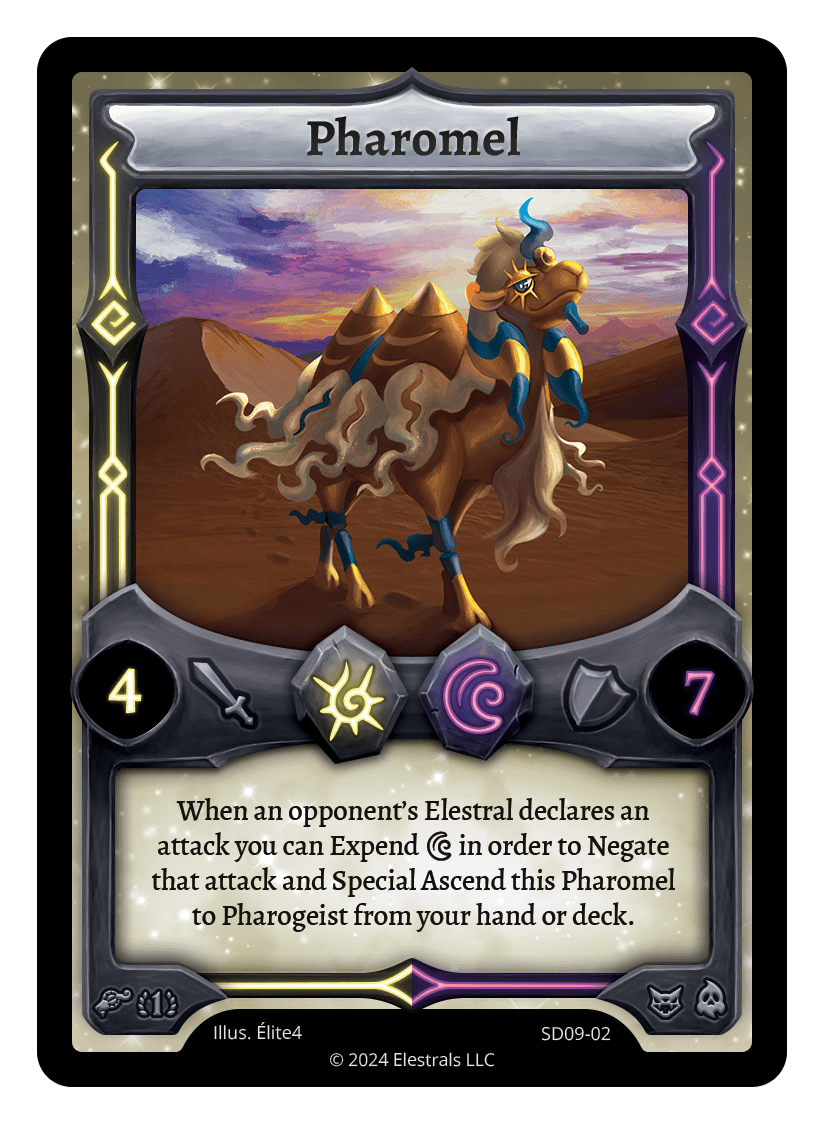

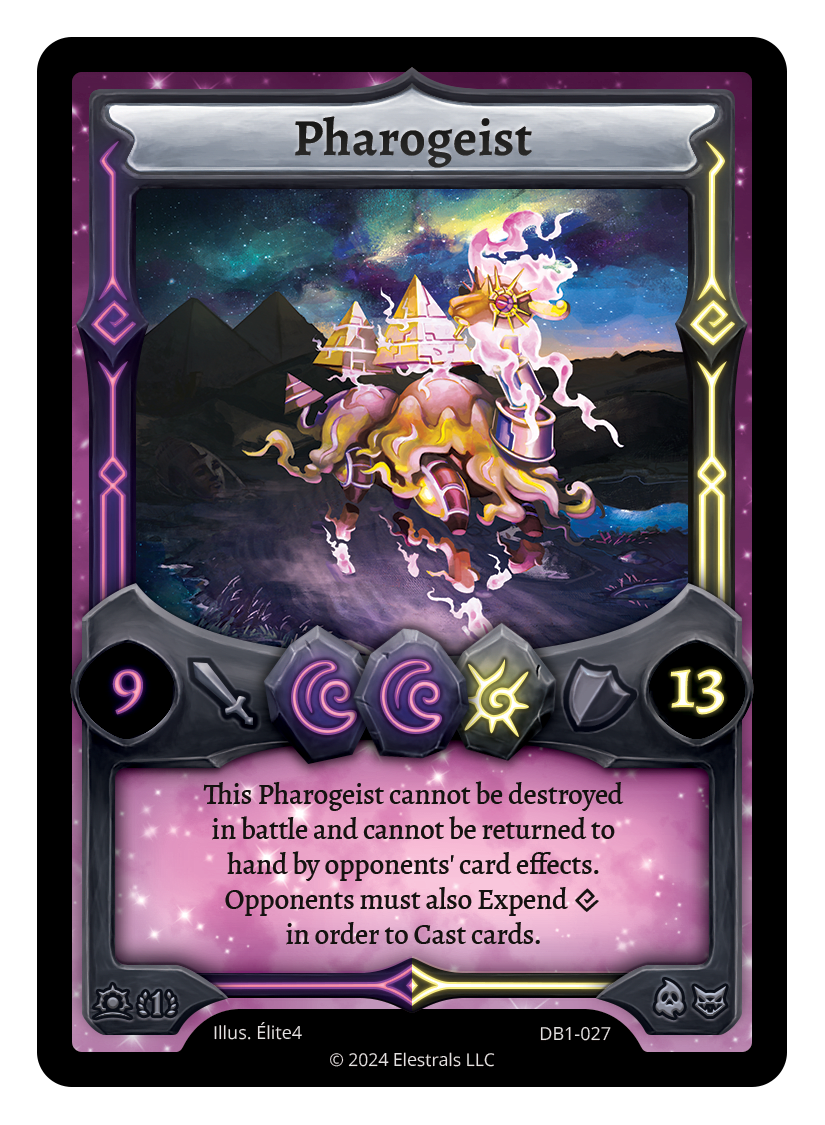




















Spirit Deck




















Komalice is effectively the same Elestral as Exaltus, only with better stats and searching Spectrals instead of Ethereals. Because of this, we can use the same playbook as before, utilizing Argo as a way to not only stick the Komalice, but also to provide the necessary spirits for the nexus play. This line will give you access to a full Camel drop on a dime, but we also have a more unusual inclusion here in Pharomel. That’s right, we’re playing the CORRECT way into Pharogeist. Pharomel sticking is a bit of a hard on to navigate thanks to it being able to negate ANY attack to ascend up to Pharogeist, not just an attack into itself, meaning you are much freer to make big swings with cards like Galaxea Champ afterwards. Unlike the other 2 3-Drops we’ve focused on, there should be no hesitations, reservations or concerns, just start swinging the second that Camel comes down and don’t relent until the game is over.
Conclusions
Towers Elestrals are in a bit of a crossroads as we enter Lifestream specifically because of the newly revealed as I’m writing this Novacore Champ, who can pop an Elestral without targeting on cast. While previously there has been little to no proper recourse to a Towers full sticking to the board, it seems with every set there’s new option to skirt around that protection, from Helialith to Spinosect Champ to now Novacore Champ.
In any case, outside of the edge case matchups, the proper play and maneuvering with these Towers can win you games you had no business in winning, and to me that makes them quite the interesting case study. I know personally Voltempest is still my favorite Elestral in the game, and if it’s possible to run I’m going to find a way in any format. I hope you’ve learned a thing or two from my TED Talk, and hopefully I’ll see an influx of these strategies in the Clash ladder shortly (at least the ones that are available).
A Quick Overview and Guide for What Decks to Try Out on Day 1 of Elestrals Clash! Early Access, With 1 Option for Each Element
A primer going over the various options when building Frost for the Firestorm metagame, discussing 5 different options for deck building.
